Diving into the eNPS Survey to Improve Employee Engagement and Performance
Diving into the eNPS Survey to Improve Employee Engagement and Performance
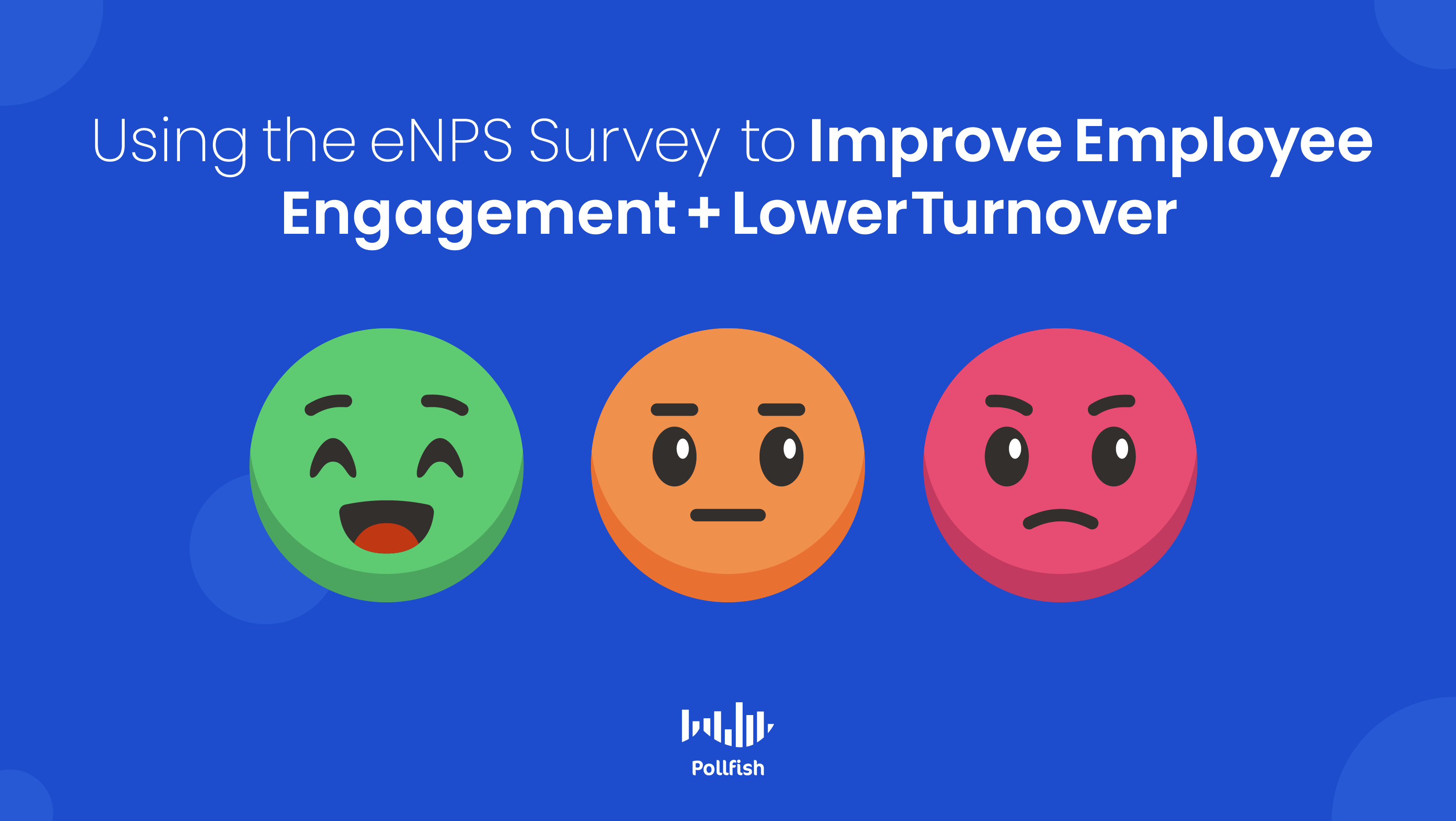
The eNPS survey, a shortened form of the Employee Engagement Survey, is a practical method for measuring employee engagement and employee satisfaction.
Employee engagement is not merely useful for lifting morale but it also yields positive business outcomes. Not only do engaged employees outperform their non-engaged counterparts, but companies with high employee engagement are 21% more profitable.
Companies with higher employee engagement also succeed in a number of other fronts. Businesses with higher employee engagement have 18% higher sales productivity and 18% less turnover.
Despite these figures, only 36% of employees are engaged in their workplace. Evidently, there is a disconnect between businesses and employees. Companies can turn this bleak statistic around, by better understanding their employees with the eNPS survey.
This article explains the eNPS survey, its importance, calculation, examples and more.
Understanding the eNPS Survey
This kind of survey is based on the premise of the NPS (Net Promoter Survey), but in relation to employees, hence its name. Designed to measure employee loyalty, this survey is a technique for gauging how willing employees are to recommend their workplace to their friends, family or peers.
While the NPS survey measures customer loyalty, the eNPS survey measures employee loyalty, and does so in the same manner — by way of asking the “ultimate question” and by implementing a scaled response, using a scale of 1-10.
The “ultimate question” is poised in the same way, but rather than focus on the company, the products or services, it focuses the inquiry in relation to the employer. Here is an example of the “ultimate question” for the eNPS survey:
On a scale of 1-10, how likely are you to recommend working at your company to a friend or acquaintance?
A few other examples:
- On a scale of 1-10, how likely are you to recommend your employer to a friend or acquaintance?
- On a scale of 1-10, how likely are you to recommend our organization/company to a friend or acquaintance?
- Considering your complete experience, how likely are you to recommend our company to a friend or acquaintance?
When employees answer this core question of the eNPS survey, their response is then tallied as an eNPS score, which reveals the sentiment and consequences behind the employees’ answers. This kind of survey has various benefits.
The Importance and Benefits of the eNPS Survey
The eNPS survey is critical for businesses of all sizes to conduct and offers various benefits. The foremost importance that this kind of survey carries is that it gives businesses a quick and easy way of obtaining an overview of employee engagement and loyalty.
This survey further reveals how much of an employee pool is content and how much of it isn’t. Therefore, it highlights which employees are happy and which aren’t, along with how to begin implementing changes for a more engaged workplace.
This survey can also be used as a time measurement metric to see how various changes throughout a quarter, year or another period of time affected employee engagement.
The Employee Net Promoter Score Survey has various benefits, such as its short format that requires little to no time from the employees to complete. It can also be expanded with follow-up questions for a more in-depth understanding of the reason behind their score. Thus, this survey allows businesses to understand why employees feel the way they do about their companies and allows them to improve on this front.
It is also simple to create and deploy, though this benefit will depend on the online survey platform businesses use.
The shortness and simplicity of this kind of survey wards off survey fatigue and prevents survey attrition. It is also easy to calculate the results and to use them for actionable insights, along with benchmarking and setting goals to manage employee engagement.
Due to the relative ease of creating this kind of survey, drawing conclusions from its single metric and its ease of participation — it is practical to apply it at continuous intervals.
All in all, the eNPS survey is a succinct and simple way of calculating a critical component of a business: its employee engagement. Understanding the levels of engagement within a workforce allows businesses to understand the reasons behind employee performance, how to improve their engagement and in turn, pave the way for employee loyalty.
How to Calculate the eNPS and its Numerical Significance
As explained in a previous section, the eNPS survey is based on its eponymous eNPS score, which is derived from a scale of 0-10 on the “ultimate question.”
After an employee answers this question based on a number on this scale, their score categorizes them as one of the three eNPS categories: the detractors, passives and promoters.
These categories represent the kinds of employees a business’s employees fall under in terms of their engagement and satisfaction with their company. Each category is based on a rang of scores, rather than just one.
The following explains the three types of eNPS employee categories:
 The Detractors
The Detractors
- Score from 0-6
- Highly dissatisfied employees
- Risk spreading negative feedback about a company
- Businesses should avoid these the most
- Businesses must work the most diligently to improve detractors’ engagement and satisfaction with their business, or else they may burnout, quit and write poor reviews.
The Passives
- Score from 7-8
- They bear neither negative nor positive feelings towards their employer
- Considered mid-range in terms of their feelings towards recommending thor company
- They are neither emotionally invested nor disengaged
- Passives require a little push to raise their satisfaction and engagement levels. They may leave lukewarm comments about their employer.
The Promoters
- Score from 9-10
- Highly satisfied and engaged employees
- They spread positive feedback about their company
- These are the most coveted employees
- These employees can become company advocates and improve the reputation of any company.
The eNPS Formula
The eNPS score is never based on one employee. Rather, it is a calculation of all the employees who took part in the survey.
As such, an eNPS score can range from -100 to 100. Scores above zero are considered decent, although company standards will vary. Generally, a score of 10-30 is considered good, and a score of 50 is excellent.
Researchers must first determine the kinds of employees that their survey respondents fall under based on the three categories of detractors, passives and promoters. Then, they can calculate their eNPS based on a particular survey study.
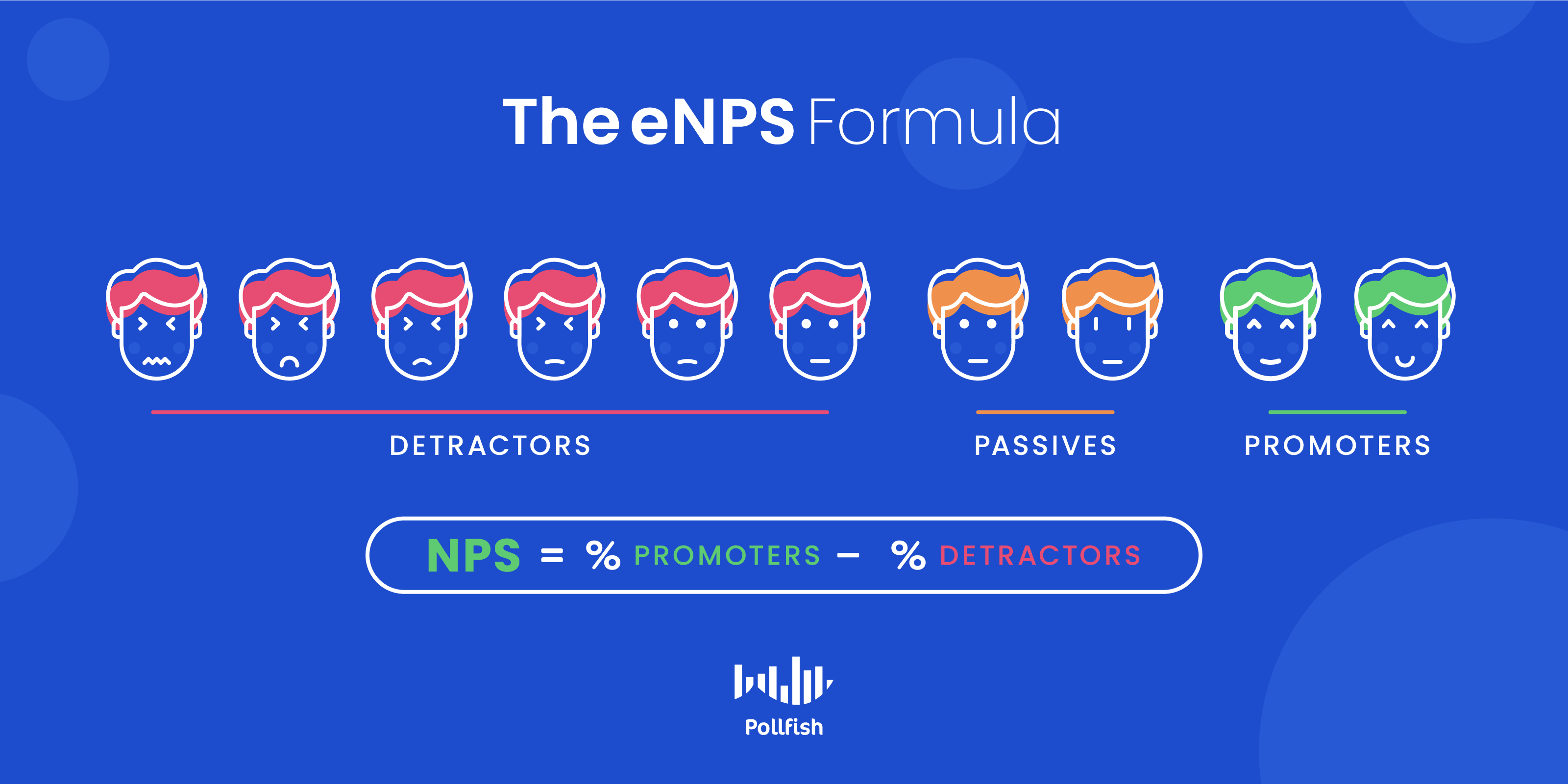
The employee Net Promoter Score uses the following calculation: the number of promoters minus the number of detractors, divided by the total number of respondents, which is thn multiplied by 100.
Ignore the passives, as they are considered neutral.
Therefore the eNPS formula is expressed as:
eNPS= (No. of Promoters – No. of Detractors) / Total Number of Respondents x 100
For example, in a company of 100 employees, 25 rated the company a 9 or 10 (they’re the promoters), 52 rated the company between 0 to 6 (they’re the detractors). Thus, the calculation becomes:
25- 52 = - 27
-27/ 100 = -0.27
-0.27 x 100 = -27%
-27 is a poor score as it is well under 0; businesses should aim to score at 30, or above 0 at the very least.
Using Survey Research to Improve the eNPS Survey Results
Regardless of its eNPS score, a business must look beyond this kind of survey to understand the reasons why employees feel a certain way towards their companies.
To remain in good keeping with employees in general, business owners should conduct an employee feedback survey regularly.
Specifically, they ought to run a pulse survey to understand their employees' sentiments, along with those of their customers and vendors. All of these players are key to sustaining a business, so they must be catered to properly. In order to do that, a business should understand all of their pain points, needs, desires and anything else that relates back to a business.
Survey research provides a strong vehicle for extracting all of these insights and not just on a quantitative basis. Surveys can provide qualitative market research, the kind that provides context and reasoning behind respondents’ answers.
Even in an eNPS survey itself, this survey can provide more than just a means for calculating the eNPS score, as businesses can use it to ask follow-up questions. These include open-ended questions that allow businesses to learn why a respondent answered in a particular way, or provided a particular score of 0-10.
Therefore, other employee surveys, such as those aforementioned, provide keen insight into the minds of employees (and customers). Access to this kind of information enables businesses to make informed decisions and effect critical changes, the kinds that improve employees’ perceptions of their employers/companies and make them more inclined to stay with their company.
In this way, survey research can improve workplaces, cut back on turnover and maintain a positive reputation of a business, especially in terms of its employee relations and general work environment.
Improving Employee Relations and Creating a Positive Work Environment
Data is vital for assessing employee engagement and perceptions at large.
Surveys allow businesses to unearth all kinds of employee perceptions in relation to a company — the kinds they would otherwise not know about. A strong online survey platform can help obtain this kind of information, along with deploying it.
There are virtually no other competent means for obtaining employee feedback in such a quick and anonymous way. One-on-one interviews, for example, are not as useful as surveys, as they strip away the anonymous element, leaving employees unable to answer as honestly as they could. These interviews are also more time-consuming than surveys.
A strong online survey platform offers a powerful solution for creating and administering an eNPS survey and facilitating survey research in general. Such a platform can carry out a vast amount of customer and employee research, allowing businesses access to critical data on many fronts. A strong online survey platform should also include artificial intelligence and quality checks, so that businesses and market researchers only get the finest quality of data.
Why a Business Needs Enterprise Survey Software for Success
Why a Business Needs Enterprise Survey Software for Success
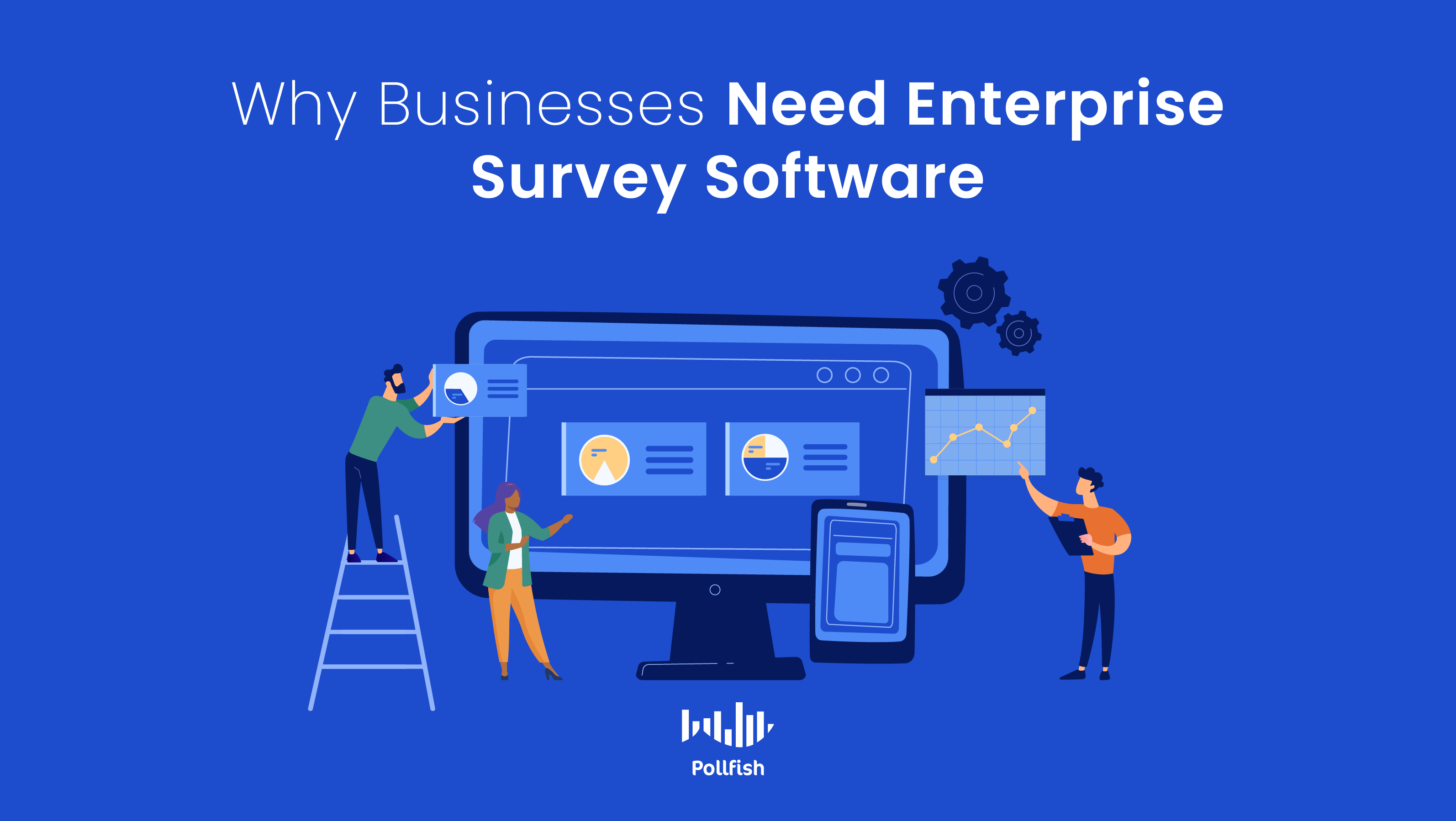
When endeavoring the various available market research techniques, a business must rely on enterprise survey software. Given that market research incites business growth and success, businesses ought to channel their growth strategies into a valuable market research tool.
However, many entrepreneurs and businesses forgo the market research process entirely, which leads to business failure. In fact, one of the top reasons that businesses fail is due to the lack of conducting market research.
Therefore, a business must invest into its market research endeavors, as they result in major improvements when it comes to growth and scaling. This is largely due to the fact that this practice involves understanding a target market — the group of customers most likely to buy from a business.
Despite the large swath of free online survey platforms, a business would benefit more from enterprise survey software.
This article explains enterprise survey software and why a business is better-suited with it instead of a basic, free survey tool.
Understanding Enterprise Survey Software
Enterprise survey software is the highest tier of survey software, offering premium functionalities, services and plans. This is to say that this kind of software does not solely refer to survey plans of the enterprise variety, although this is usually one of the options.
However, in regards to its name, it is equipped for large enterprises, although businesses of any size can benefit from it. Unlike a basic survey platform, which offers free services, enterprise survey software provides far greater and powerful survey campaign-building.
Some providers of this kind of software may offer free versions, which are limited iterations of it, meant to give researchers a sample of the software. Others may offer a freemium version, that is, a free version with premium chargers for supplemental features.
Businesses that strongly rely on market research, or intend to gain firsthand insights on their target market or any target population will need to use enterprise survey software. This way, they will have the leeway to tailor their surveys entirely to their likely and send them to the appropriate audiences.
How Enterprise Survey Software Differs from a Basic Online Survey Platform
Enterprise survey software maintains several differences from those of a basic, standard or free online survey platform. All of these differences render enterprise software as the superior option, as each functionality and service carries an advantage in the market research process.
Here are some of the major ways in which this kind of software differs from its free, standard or basic counterparts.
- Mobile-first surveys
- While most companies claim to be mobile-first, most survey software is not ideal for mobile usage, as some question formats are simply not designed for the mobile experience.
- Enterprise survey software uses a mobile-first approach to ensure easy usage of surveys, the inclusion of the questions you’d see on desktop and more survey incentives offered in native apps (from partner publishers of the platform).
- First-Rate Quality checks
- This kind of software is usually equipped with quality checks to ensure only the highest quality of data is funneled into the surveys’ results.
- Checks that avoid survey fraud
- Multiple layers of quality checks to avoid respondents who don’t pay attention to questions.
- Random Device Engagement (RDE)

- A method of randomization and iteration during survey deployment, in which respondents are extracted from their natural digital environments rather than being pre-recruited.
- River sampling software cannot monitor or track respondents, thus cannot avoid duplicate surveys and other fraudulent activities that skew the data.
- Provides respondent verification: checks on duplicate respondent IDs via their IP or MAC addresses, Google Advertising and mobile device identifiers.
- AI and machine learning
- Provides automated quality checks, so no post-survey manual labor is required.
- Quickens the survey sampling process while filtering through and disqualifying sub-par and low-quality data.
- Removes bots
- Disqualifies those who don’t complete their surveys or provide gibberish answers, hasty answers or flatlining
- A global support network
- Enterprise survey software providers have global tech support employees working 24 hours, so that researchers are never left without a helping hand.
- Supports global audiences with round-the-clock assistance and survey available in 46 languages.
- An exhaustive survey platform experience
- The most recognizable and clear-cut distinction between free and enterprise survey software, since the former offers a limited version of what would be a fortified system.
- Offers a wide variety of questionnaire functionalities: question types, predefined answers, batch answers, advanced skip logic, adding media to questions, recalling information, carrying forward answers
- A robust system for all
- Designed to be used for the democratization of data; all team members should easily access the insights and run surveys
- Allows you to make your own survey in 3 easy steps
- Enhanced dashboard and data visualizations
- Results are available in various formats: charts, graphs, Excel files, SPSS, crosstabs and more
- Clearly laid out demographics filters and data pertaining to demographics and screening conditions
- SaaS integrations and agile data
- Integrations with the main dashboard and an external one to reap the capabilities of more than one software provide
- Provides agile data, a system that ensures smooth collaborations across systems and speed to insights
- Data Security and compliance
- Adhering to all data privacy legislation, including the GDPR
- Researchers, publishers and respondents can make data requests in regards to personal data, so as to verify that they are comfortable with the data they provide.
- Specific request types include:
- Consent Withdrawal
- Access request
- Rectification of personal data
- Erasure of personal data
- Restriction of processing of personal data
- Personal data portability request
- Objection to the processing of personal data
When to Use Enterprise Survey Software
There are various points at which businesses ought to consult and consolidate with enterprise survey software into their market research endeavors. Whether you begin a new campaign or have gathered secondary research on a topic, it is best to choose enterprise survey software over standard survey platforms.
Why? A business cannot wait to gain results, let alone market research insights to drive such results. A basic survey platform lacks on a multitude of fronts, many of which are divulged in the section describing how this software differs from the enterprise kind.
Additionally, free survey software does not have the capacity to use multiple audiences per survey, nor can it gain a large volume of respondents per survey. This kind of software is therefore far less powerful and this will show in the results.
This is because the results will not offer the same kind of quality in the data, be it from the way respondents are extracted or their responses themselves.
Enterprise-grade software creates enterprise-grade surveys and survey campaigns. Thus, they are far more useful and reliable for any market research campaign, whether you seek to study a particular segment or your target market.
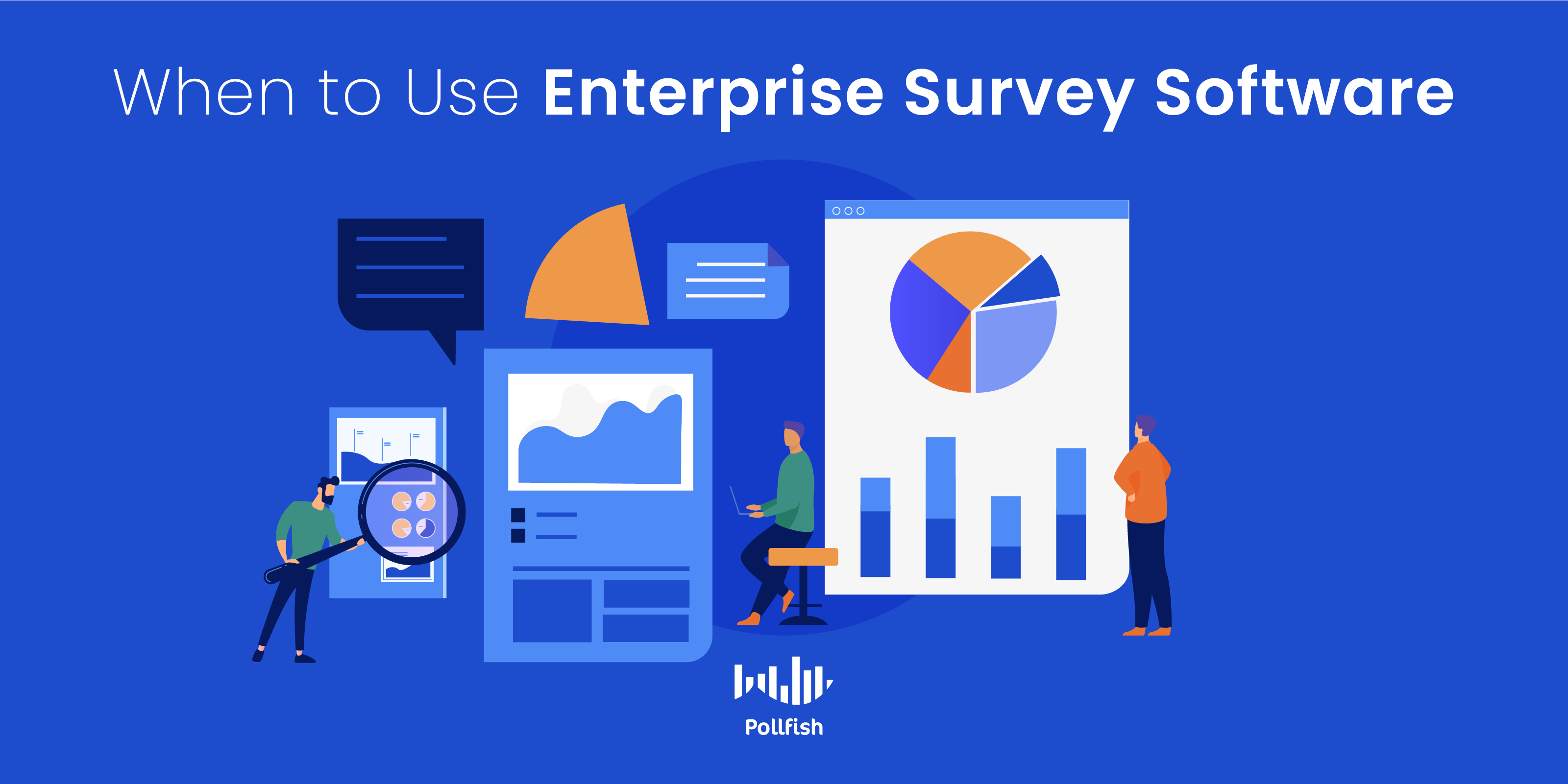 As such, businesses should rely on this kind of software at any point in their market research needs. This breed of software handles the following with ease:
As such, businesses should rely on this kind of software at any point in their market research needs. This breed of software handles the following with ease:
- Create a complex system of data based on answers and audience types
- Organize complex data into digestible formats
- Parse through responses and create test questions to assure respondents are paying attention
- Create a robust system of visualizations and analytics
- Complete surveys according to all their preset quota in a small window of time
Finding the Correct Online Survey Platform
It has become progressively more important to understand your target market in order to foster customer loyalty and retention. With stiff competition and continuous innovations, businesses must know their customer base inside-out in order to please it.
They can achieve this with the correct online survey platform, so long as it is built on enterprise survey software. This kind of software can level up any research campaign efficiently, reducing the amount of manpower, labor and resources that lower quality software would require.
As such, businesses ought to settle on a single platform in order to centralize their data and create an easy point of reference. This will require them to check just one platform to choose respondents, deploy surveys, create surveys, analyze results and take part in data-driven decision-making or DDM.
How to Conduct SaaS Market Research Like a Pro
How to Conduct SaaS Market Research Like a Pro

Conducting SaaS market research is a requisite for business owners, market researchers and marketers who seek business success in the competitive landscape of cloud services.
SaaS remains a booming industry, with upward trends forecasting it to amass $832.1 billion by 2025 in revenue by 2025.
Clearly on the rise, the SaaS industry has surpassed all other cloud services in revenue, including Cloud Application Infrastructure Services (PaaS), Cloud Business Process Service (BPaaS) and others.
This is because all sectors are seeing both SaaS innovations and the adoption of SaaS solutions. The Covid-19 pandemic has contributed to the dominance and growth of SaaS, as SaaS applications bolster remote working, cutting back on the need to be present in in-person meetings and other work gatherings.
This article explains SaaS market research, allowing professionals of all backgrounds to conduct it to stay well-informed and competitive.
Defining SaaS Market Research
SaaS market research refers to all the market research techniques used to extract up-to-date information on the Software as a Service space, a market of its own.
SaaS does not merely refer to software companies; rather it is a cloud-based service in which applications are run online, eliminating the need to download software onto a desktop or business network. This kind of convenience gave rise to accessibility, operational ease and accessibility, which has largely contributed to its growth and popularity.
To remain in good standing in an increasingly competitive industry, all SaaS companies must conduct market research. However, it is not just the businesses in this market that must conduct SaaS market research.
All businesses that use SaaS products should perform market research on the SaaS market to ensure that they are using the most productive and cost-efficient product.
Market research in this space involves secondary and primary research on the overall industry, along with its changes, trends, target market and key actors — the competitors of a business.
How SaaS Market Research Differs from Technology Market Research
Given that SaaS is a market of its own, it should not be conflated with technology market research, which refers to market research on the overarching tech space. The technology sector is composed of hardware, software and IT services subsectors.
The SaaS market refers to SaaS companies alone, however, they too make up the broader landscape of technology, as they use a kind of technology.
SaaS can run contrary to IT, which can represent hardware and infrastructure, whereas SaaS is solely cloud-based. IT professionals often use SaaS products for a wide range of purposes including governance and operations.
Therefore, IT professionals and providers can benefit from conducting SaaS market research, whereas, SaaS professionals may not need to perform technology market research, as their needs are specifically within the SaaS space.
Secondary Sources for SaaS Market Research
Before conducting primary research, market researchers ought to begin with a general status of the SaaS industry. Secondary research is the ideal means for this, as it covers key information on various aspects of the industry. Best of all, you don’t have to conduct it yourself.
Bear in mind, you should check for research that is as up-to-date as possible, as industries are in a continuous state of change and SaaS is no exception.
If you are not a researcher for a SaaS company, you can still benefit from conducting secondary SaaS research. For example, if you need to justify using a SaaS product for your business, conducting market research can help you do so by providing key stats, figures and facts. These can help you form a business case to purchase a SaaS product for a business you work for.

The following provides critical secondary resources for SaaS market research:
- SaaS End User Spending Worldwide Report (2009-2022)
- A data visualization from Statista on the growth of user spending in the SaaS sector in a 13-year period.
- A statistical overview of the state of the industry in terms of spending.
- 50 Biggest Public SaaS Companies in the US
- Companies presented via tier market cap
- Updated weekly
- The page also provides the highlights of the SaaS industry from the previous year.
- SaaS Trends and Growth Projections 2021
- A page rich with various statistics on the trends and changes in the SaaS space.
- Several stats explain the needs of the industry, invaluable advice for keeping your SaaS afloat. Ex: Half of all SaaS companies rely on user-based pricing for profit.
- Marketing Publications Geared towards SaaS
- Bent on exploring marketing strategies to reach the specific target markets in SaaS.
- Ex: How SaaS Marketing is Different
- Ex: Growth Marketing Strategies for SaaS Products
- Competitive Analysis
- Rounding up competitors via keyword searches on SaaS products.
- News sites that feature press releases from competitors
Primary Sources for SaaS Market Research
While secondary resources provide utility for market analysis, competitive analysis and trends, primary resources allow you to form a deep read of the people who keep your business in business: your target market.
This is because, when you conduct primary research, you are equipped with asking any inquiry you desire, a feat not possible with secondary sources alone. While they are necessary to analyze, they will not answer your specific questions — at least not all of them.
You’ll find that in some instances, you may even study your competitors firsthand.

The following provides critical secondary resources for SaaS market research:
- Focus Group
- Provides s group discussion on topics with moderation from a host
- Offers an intimate setting, as it involves no more than 6-10 participants
- One-on-one interviews
- The most intimate kind of primary research
- Can be difficult to find participants, even in the age of Zoom meetings
- Direct talks with competitors
- Via competitors chats, along with emails and phone calls as their prospects
- Require stealth in order to extract information without revealing yourself as a competitor
- Customer Development
- The mid-section of the lean startup model
- A structure used to confirm that a product satisfies the needs of a target market.
- Dictates how startups must form and be managed, to effectively launch a product.
- Online surveys
- Can be deployed to a massive network
- Allow for respondent anonymity
- Can be set in a wide variety of manners such as the examples below and many more
- Allow you to ask both quantitative and qualitative questions in a number of formats
Excelling in the SaaS Space In Spite of Stiff Competition
Whether you work for a startup or a long-established SaaS business, your company can benefit from conducting SaaS market research. This task is designed to be performed periodically, as technology moves at the speed of light, taking its customer needs and overall industry with it.
To stay ahead of the curve and offer a valuable product and customer experience, you should invest in primary and secondary resources alike. As aforementioned, certain secondary sources are free, while others aren’t.
Primary sources are seldom free, unless you manage to land a complimentary interview, or pose as a prospect on chats, emails and phone calls with competitors.
However, they are often the most insightful, as it put the researcher at the reins of the research, allowing them to ask any question they desire for a market research campaign. An online survey tool is one of the most potent means for garnering primary research, as it enables researchers to create various survey types and distribute them to relevant respondents. A proper online survey platform will deploy surveys to a wide network of popular websites and apps, offer random survey sampling methods and a host of other features to facilitate market research.
How to Reach the Correct Target Market Sample to Understand Your Customers
How to Reach the Correct Target Market Sample to Understand Your Customers

A target market sample to market research is what a target market is to a business: of critical importance. This is because market researchers must conduct research on the correct sample of the population.
When it comes to business, this sample is largely made up of a business’s target market, i.e., the segment of the population most likely to buy from the business. In order to build effective survey studies and perform valuable market research, you need to specifically examine the target market sample.
Finding this sample can be difficult, let alone contacting it. This article explains the concept of the target market sample, including how to properly determine its members and reach out to them for your market research needs.
Defining a Target Market Sample
A target market sample is a kind of market research sample; this concept denotes a group of people who participate in your study, representing an entire targeted population.
A target market sample is a specific kind of market research sample. As its name implies, it is a sample that represents your target market, as it is made of the people in your target market. If you do not know how to identify your target market, conducting market research is the best way to accurately determine it.
In particular, effective survey studies can help you determine the members of this group. You can further divide the group into specific segments by way of market segmentation. While this practice is a critical subset in marketing, it too can be conducted via market research, including survey research as a primary method.
A target market sample works symbiotically with market research, which is to say that one relies on the other to achieve its best performance. This is due to the fact that you need to be acquainted with this sample, as learning more about it is crucial for your market research.
Concurrently, performing market research correctly will help you define your target market sample, allowing you to cater to this group correctly, which in turn will increase sales and profits.
The Importance of the Target Market Sample in Market Research
As aforementioned, a target market sample and market research share a symbiotic relationship. A target market sample is critical to market research on several other grounds. First off, it is used in both probability and non-probability sampling.
These are the two major sampling sources in survey sampling methods along with other market research methods. For example, you ought to conduct studies on your target market sample during other primary research such as interviews, VoC programs and focus groups, along with secondary research like trade publications, statistics providers and verticalized websites.
This group is not merely applicable to these forms of research; rather it is necessary. Here are several ways that prove the importance of garnering and studying your target market sample.
- Before studying your target market, you must ensure that you are reaching the correct people. A target market sample comprises them.
- Wasted efforts are too costly and time-consuming, thus, you have to be in touch with your target market.
- You need to understand your customer base for all marketing and business endeavors.
- Understanding your target market samples assures that you reach the correct people for future research and non-research undertakings.
- This sample allows you to form data-backed characteristics about your customer base, as you can safely vouch their representation of your target market.
- You can build personas by reaching and studying the correct sample.
- You can perform qualitative research along with statistical research
- Having access to this sample means you will be able to make informed predictions about your target market.
Determining Your Target Market Sample
Given that one relies on the other, you must conduct market research properly and define your target market sample accurately before proceeding.
To identify your target market, you must first conduct some secondary research. Although this action is best-suited for startups and those new to the business world, long-established businesses can still benefit from this, as consumer interests change.
For example, not too long ago, Facebook was considered a social hub for college students and the younger generation. But in the current year of 2021, 46% of older Americans use Facebook. As a matter of fact, Facebook is the most-used social media platform among seniors.
You’ll find research on your target market and some of its segments in secondary sources such as brand literature (reports, case studies, blog posts, articles), news sites (in your niche) and sites dedicated to market research.
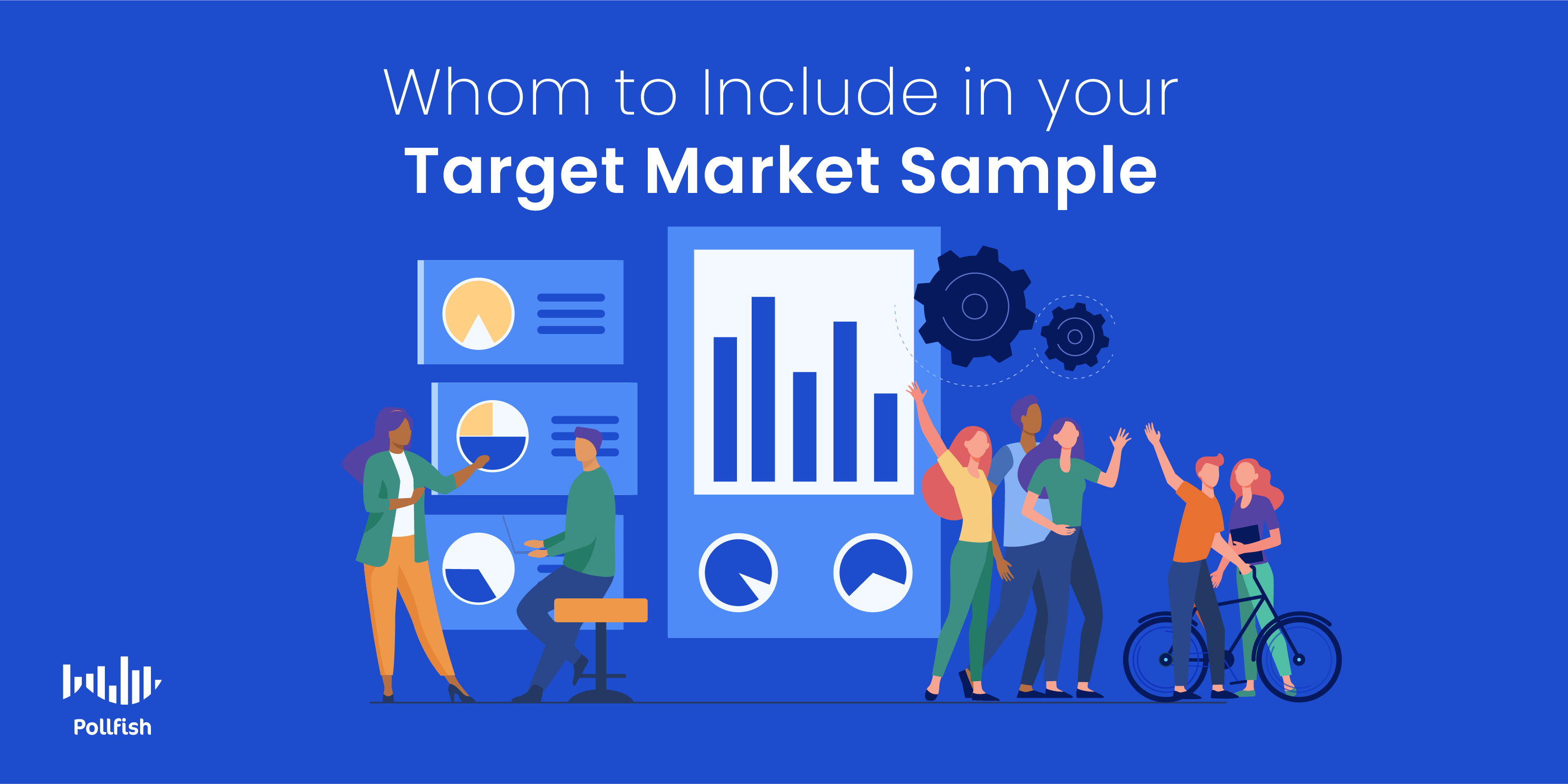
While secondary research is a good starting point, it does allow you to fully capture the makeup of your target market. Therefore secondary research alone is inadequate for obtaining your true target market sample.
Instead, you must learn who comprises your target market sample via primary research. There are various market research tools available, but they are far from equivalence.
In order to form the makeup of your target market sample, that is, before, you reach out to it for concrete marketing campaigns, you must first employ an easy-to-use tool for such a campaign, the kind that allows you to amass their key traits and preferences.
Survey research is a rescuing aid, as you can survey suspected members of your target market (based on previous secondary research) to understand them better. In such a case, you do not need to set up a strict screening portion on demographics, as you are still learning which demographics to use in your sample.
Create these initial surveys to learn more about your suspected target population. Search for trends among ages, geographic location, ethnic groups and cultures, along with lifestyles. This will help you get a feel of who is most interested in your niche and most importantly, your product, service or experience.
During your survey data analysis, segment your respondents based on their opinions, preferences and demographics information. You can disregard the demographics who show little to no interest in your offering.
Continue this process should you require market segmentation, to further organize your target market into smaller segments. Segmenting your customers is critical for providing personalization.
With these actions, you are able to identify who to include in your market research or survey sample.
How to Reach the Correct Target Market Sample
Secondary sources can appear to be arbitrary sources of research, whereas primary sources allow you to wield full control — at least they should, in market research. As such, you should conduct surveys to extract data from the correct target market sample.
Once you’ve identified your target market sample members via secondary and primary research, you can then safely conduct market research on them for a variety of macro-applications.
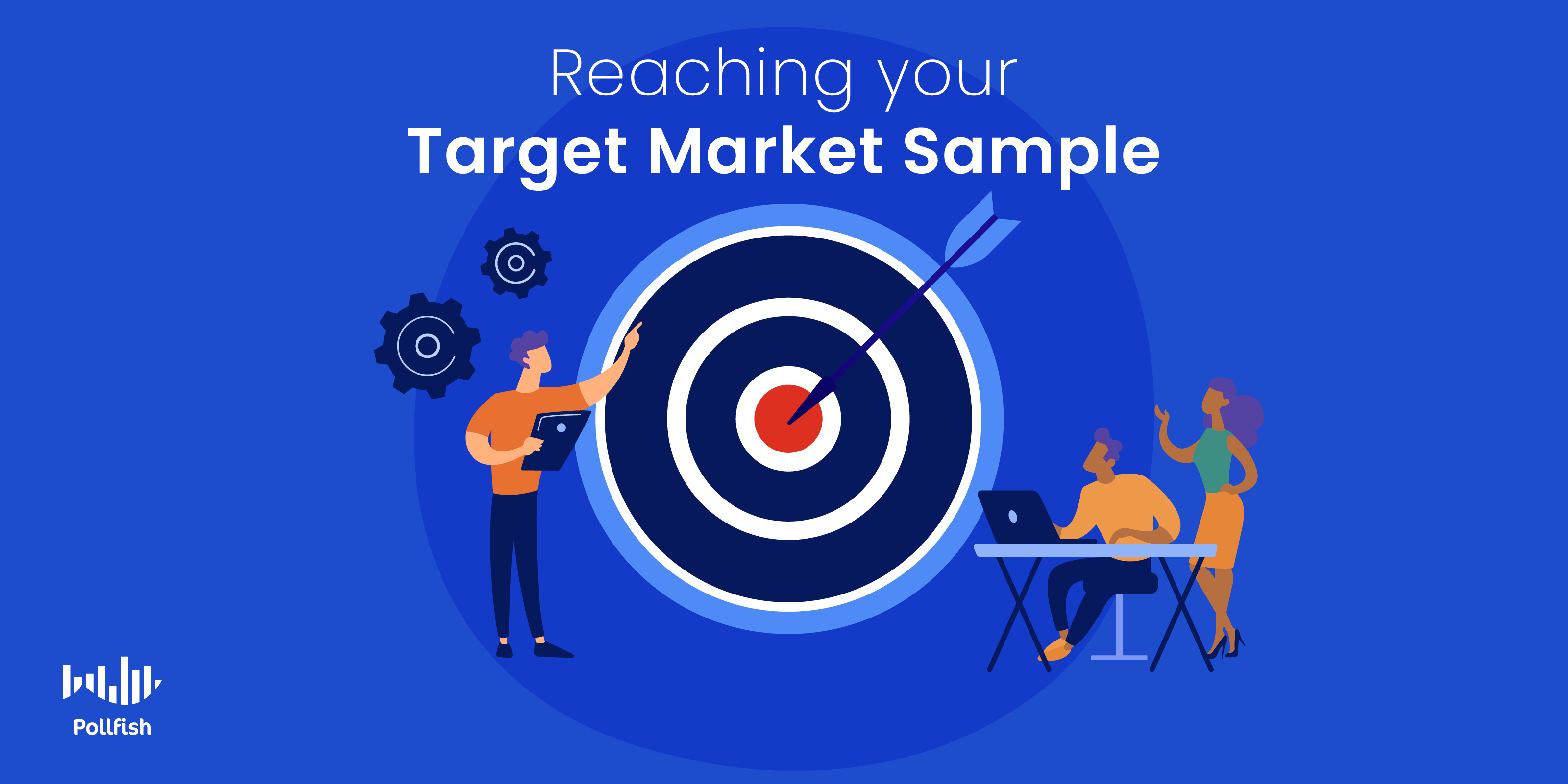 These include campaigns in the following:
These include campaigns in the following:
- customer development
- general marketing
- advertising, branding
- customer experience (CX)
- customer satisfaction
Start small by testing a general portion of your target market. This involves survey participants bound by common demographic categories. You do not need to delve into psychographic and behavioral traits just yet.
Instead, ask the more general population of your target market sample a mix of qualitative and quantitative questions. This will help you map out who they are beyond their general demographics. As such, this can be seen as an extension of determining your sample members, but to a far more precise degree.
When you get a better sense of your target market, you should then conduct more granular surveys to understand their needs. After this, you ought to create quantitative surveys in order to form statistical representations of your target market.
You can switch between quantitative and qualitative surveys, or conduct surveys that include a mesh of both. The more surveys you run on your target market sample, the more meticulously will you be able to define it.
The more accurately-defined your target market sample is, the more accurate and relevant it will be for your market research. Fortifying your market research will lead you to make better business decisions.
Satisfying to Your Customer Base
Satisfying your customer base is no easy feat. Businesses have invested long and hard into marketing. But you cannot deliver a valuable marketing campaign without understanding your target market to a T.
Thus, you need to perform continuous market research on this group of people. To do so, you must understand who constitutes your target market sample, the market research sample of your focus. A strong survey platform will help you achieve this objective.
The correct online survey platform will allow you to painlessly identify your target market sample and deploy surveys to it. After all, if you cannot reach out to your sample and extract data, then it is of no use to your business.
Thus, when you conduct market research on the members who belong in your target market sample, you will avoid useless and inaccurate research, the kind that offers no value to your company. Surveys help you ward off this risk.
The Importance of Market Research for Any Business
The Importance of Market Research for Any Business
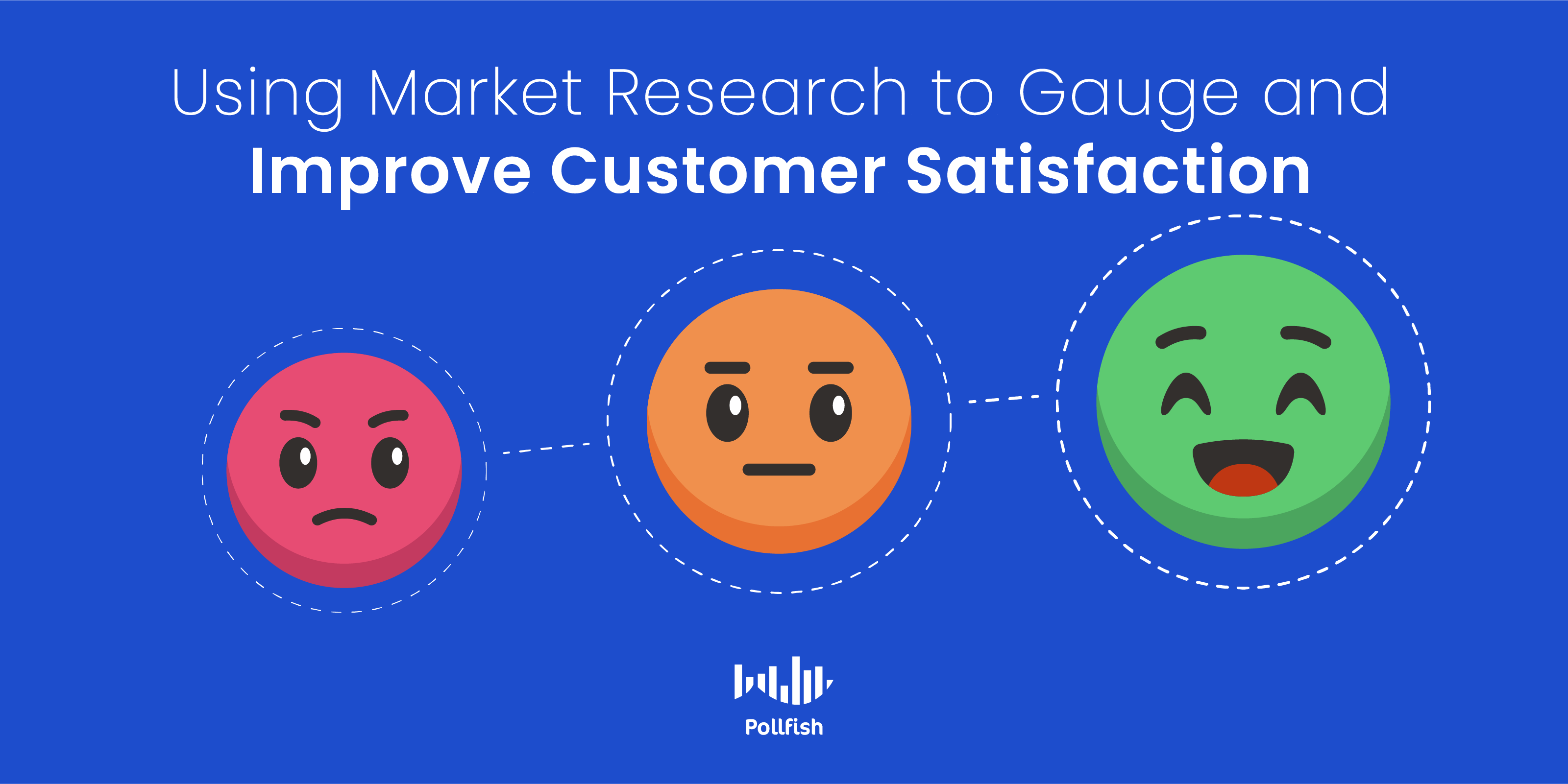
The importance of market research should not be glossed over by businesses, yet not all businesses apply it to their marketing efforts or even to their strategic planning process.
This missed opportunity has grave consequences for companies of all sizes; even large successful companies have lost billions in revenue from failing to conduct market research. Thus, all companies must conduct market research, whether they’re fledgling startups or long-established businesses.
This article expounds on the importance of market research so that businesses and researchers understand its value. It also shows how to conduct this kind of research to reach and maintain various business goals.
Defining Market Research
Market research is a specialized kind of research process; it refers to the organized methods by which an organization collects information about its target market and overall industry to inform its go-to-market gain continual intelligence on its industry at large.
Although used interchangeably with market analysis, they are not the same practice. Market analysis refers to the broader practice of studying a sector, industry or niche. This kind of analysis uses current and historical observations to make forecasts.
Market analysis primarily delves into existing business practices and products to plan for future business endeavors. Using raw data, market analysis gatherers a large supply of impersonal facts and figures. Thus this kind of research is far more general.
Make research, on the other hand, is more specialized in its design and approach, as it primarily focuses on examining a particular target market and its even more specific segments. Thus, it is far more customer-centric than market analysis.
Although the primary focus of market research is on a business’s customer base, it too involves elements of market analysis. Some market analysis projects in market research involve turning to secondary research as a means of understanding the broader environment of a market before narrowing the focus to its customer segments.
Market research can be conducted by amassing secondary resources or by conducting primary research. The latter may include using an in-house research team, which conducts market research techniques entirely on its own such as in field research, in exploratory research, experimental research or other methods.
It may also include an in-house research team that implements syndicated research or custom research. These refer to the external research methods of the receiving company, in which a market research provider conducts primary research for the business. In short, these two forms of research are a kind of outsourcing method for market research, as they represent services that extract customer data.
In syndicated research, a research project is funded by various companies and conducted by a research firm, which owns all the resulting data. Alternatively, custom research is a form of research in which a single business works with a market research provider on a project and funds it entirely on its own. Thus, the resulting data is also proprietary to the business.
The Importance of Market Research
The importance of market research is manifold. It provides various uses and can be used with multiple macro-applications and subsets of marketing, along with business needs as a whole.
The overarching umbrella of importance in market research is the ability to understand customers to the fullest extent, which includes: their needs, desires, opinions, frustrations, aversions, inclinations and other intelligence.
Understanding all of these factors in relation to a target market helps a business attract and retain customers. Both aspects are of utmost importance to a business, but customer retention is especially important, in that existing customers are far more likely to buy from a business.
In fact, the likelihood of selling to existing customers is 60% to 70%. Additionally, retained customers are 50% more likely to buy a business’s new product. Despite these figures which clearly illustrate the weight of customer retention, only 18% of businesses focus on customer acquisition, while 44% of businesses focus on customer retention.
Market research is also crucial for maintaining competitiveness. A business cannot thrive in a competitive landscape when it fails to do the necessary research to adapt to trends, new product/service upgrades and most importantly, customer needs. In fact, 9% of businesses lose their customers to their competitors when they don’t conduct market research to improve their customer loyalty and retention.
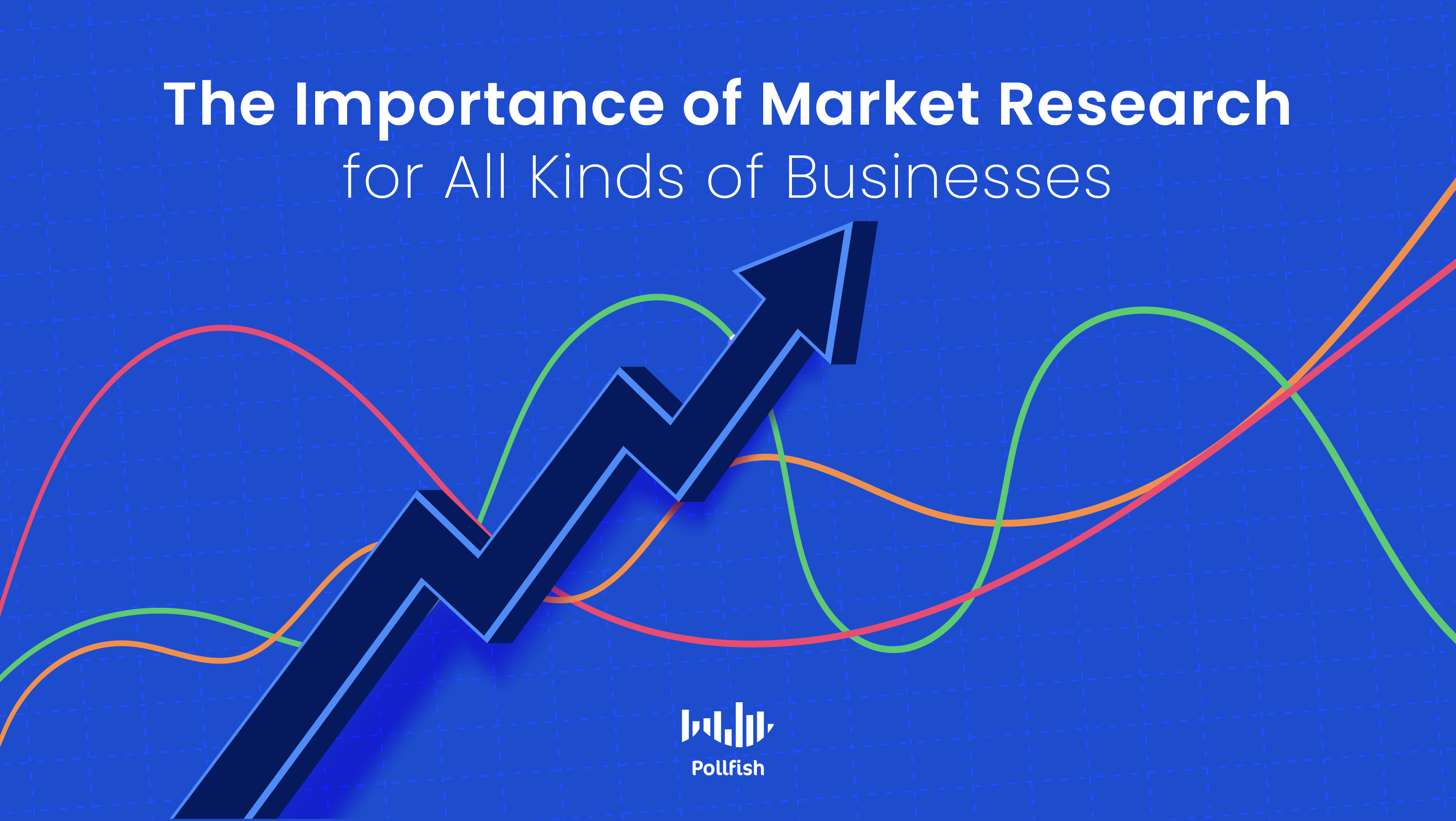
Market research helps businesses assess their customer satisfaction, whether they examine the satisfaction of existing customers or all those in their target market. As such, businesses can keep continuous tabs on customer preferences to understand how to better serve them, whether it is via products, services, customer support or digital experience (DX) across all digital channels.
Businesses can also learn customer sentiment in relation to the industry at large. This will help companies grasp their standing within their industries and in relation to their competition.
Moreover, conducting market research does not merely help businesses understand their customers' opinions and preferences. It also helps determine the exact makeup of a business’s target market via target market surveys and market segmentation. The latter identifies the subsets that make up a general target market, allowing brands to create granular messaging and campaigns to both acquire customers and retain them.
Furthermore, market research helps companies on the strategy side of a business, in that by studying their market and niche, they can devise critical documents and strategies to both launch a business, as well as propel it forward. For example, startups can use market research for business, while companies that have been in business for several years ought to use market research for their strategic planning process. The latter helps businesses map out their goals, better understand their ranking and establish practical objectives.
Finally, the customer-specific intelligence that businesses gain with market research helps support a variety of macro applications, from general marketing, to branding campaigns, to advertising projects, along with various studies such as longitudinal studies, cross-sectional studies, retrospective studies, prospective studies and others.
How to Conduct Market Research
There are many ways to conduct market research as there are various market research techniques. The two major classifications of market research are secondary and primary research.
Secondary research involves gathering and analyzing already available sources of customer data and other relevant information about a market. Secondary research can exist in a number of public resources, such as:
- Government resources: on government websites and databases
- Examples: The Census Bureau, The U.S. Small Business Administration, The Bureau of Economic Analysis and more
- Enterprise sources: trade associations, the Directory of Associations
- Research Associations: Composed of research analysts, they provide businesses with reports on specific subsectors of an industry.
- Examples: Forrester, Statista, Gartner, IBISWorldMintel: Market intelligence
- Industry blogs and content-oriented Websites: Online publications on the latest updates, trends and breaking news
- Examples: Ars Technica, The Business of Fashion, Grocery Drive, Realtor Magazine
- SEO and SEM Reporting: Tools for SEO (organic rankings efforts) and SEM (paid search)
- Examples: Ahrefs, SEMrush, etc.
Primary research refers to the various methods of amassing self-conducted research. Researchers can obtain primary research in a direct way, that is, by interviewing their target market themselves or by outsourcing.
Primary research methods include:
- Phone interviews
- In-store and in-person interviews
- Field research
- Mail-in surveys
- Focus groups
- Syndicated research
- The market research firm will be the proprietor of the extracted data
- An online survey platform
- The business is the sole owner of their extracted data
The following provides the steps that a business should take when conducting market research:

- Begin by conducting secondary research, which gives you insights into the broader market and niche. Use any of the above secondary sources, along with others.
- Look for information about the customers who belong in your target market.
- Find the patterns in your target market through the secondary sources. Keep an eye out for their demographics, psychographics, habits and behaviors.
- These will help you make hypotheses about your target market and how to best approach it for a number of campaigns.
- Next, conduct primary research via your method of choice. To do so, identify your most pressing curiosities from the secondary research you conducted.
- Tie your inquiries into a specific campaign or macro application.
- For example, do you need to conduct a longitudinal study to understand buying habits, or a study to test the effectiveness of ads?
- Conduct your primary studies with a set amount of participants.
- Surveys help you reach thousands of consumers in your target market.
- After you’ve gathered a significant amount of relevant information, perform an analysis.
- This ought to be done by more than one person within a business as different minds interpret data differently and can thus lead to different conclusions and ideas on moving forward.
- Then, ask yourself if your study is complete or you need additional data.
- If you opt for the latter, create another campaign and conduct further primary research.
- Analyze your primary data, along with your secondary data.
- Does the primary data align with the information you gathered from secondary sources? If so, it can point to repetitive behaviors or ongoing occurrences among customers.
- If not, consider the significance of the changes. Have the customers changed or has the industry changed which has led to the difference in findings.
- Additionally, primary research may not always align with secondary research, given that the business is at liberty to form its own questions and delve into its own curiosities and priorities.
- Draw conclusions and create a plan of action to reach your target market, whether it involves advertising, content strategy or any other campaign or change.
The Importance of a Strong Market Research Platform
In summary, market research is a crucial set of activities that businesses of all sizes and stages must conduct in order to better understand their industries and most importantly, their target market.
It identifies how customers view a business and allows businesses to identify and resolve gaps in customer expectations. As such, implementing a strong market research tool is an absolute must. While there are many market research tools, none are quite as potent in reaching thousands of people in a target market as online surveys.
Thus, a business should choose a robust online survey platform, one which makes it easy to design and deploy surveys, along with distributing surveys across a vast pool of digital properties. This will ensure that businesses have easy access to valuable customer data — the kind that approaches customers naturally in their digital environments, instead of being pre-recruited via email or survey panels.
How to Monitor and Increase Brand Visibility with Surveys
How to Monitor and Increase Brand Visibility with Surveys
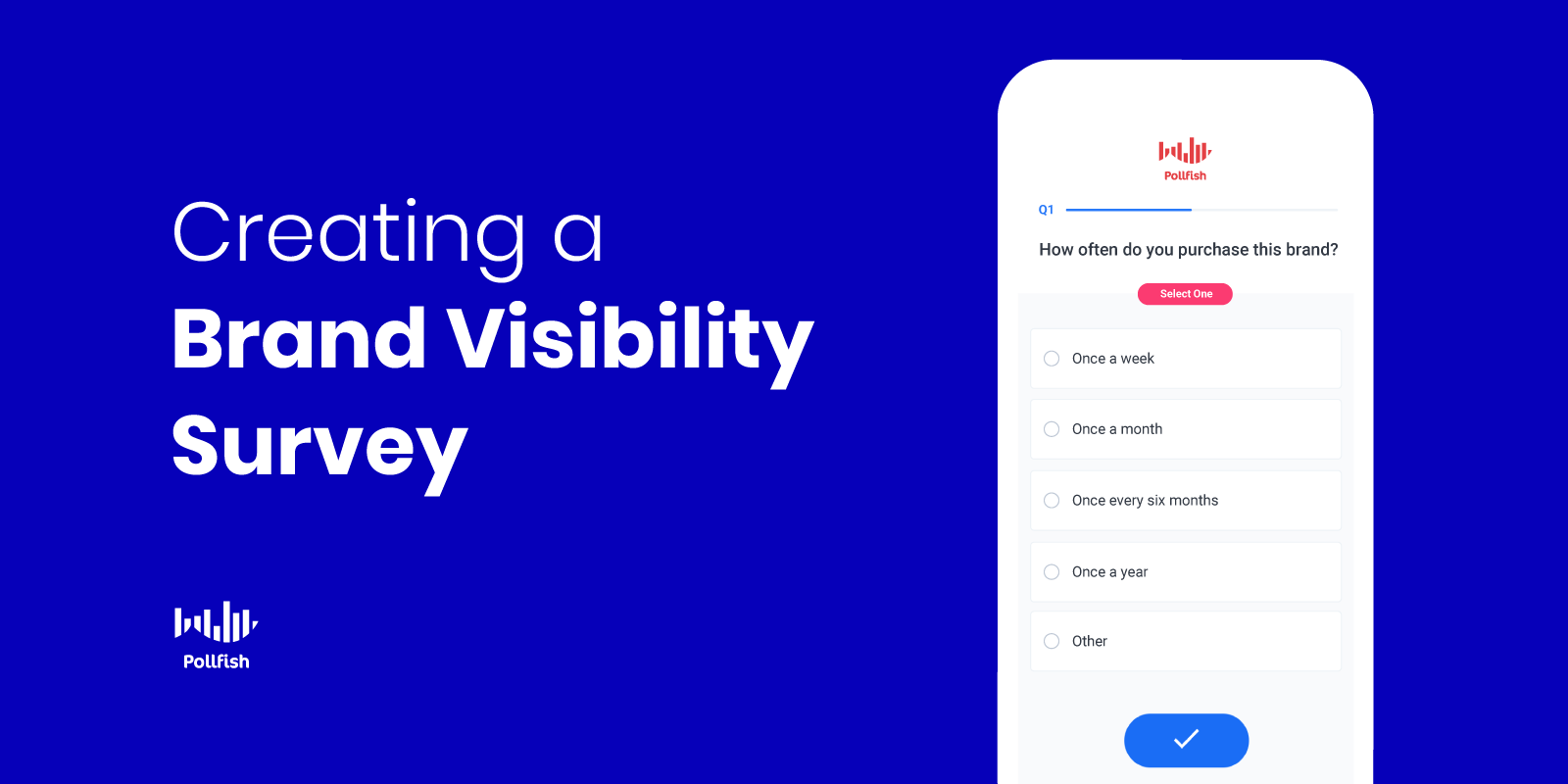
Brand visibility is a necessity for any company hoping to gain recognition within its field and compete with top players.
It is increasingly important to stand out among a crowd for businesses, as the ecommerce space is swelling to new heights; the ecommerce sector is projected to reach 4.9 billion users by 2025.
Ecommerce, in its entirety, is on the rise, as there has been a 44% increase in ecommerce sales in the previous year from the US alone.
These figures relay the presence of a wide swath of businesses and potential customers in the space. Thus, brand visibility is ever-important for a business to be noticeable by the upturn of customers.
This article explains brand visibility and its importance, along with how surveys can be used to both measure and increase brand visibility.
Understanding Brand Visibility
Brand visibility is a crucial aspect in the branding sub-discipline of marketing, but it is not a precise metric. Rather, brand visibility refers to the extent to which customers can detect and remember a brand within various environments and conditions.
An offshoot of brand awareness, brand visibility also concerns itself with those who have heard about a brand and how much they know about it.
However, rather than mainly focus on recognition and recall, the main concept of brand visibility is the condition of having keen knowledge of a brand and frequently keeping it in mind.
In order to achieve this, brand visibility also deals with the exposure of a brand. For example, a brand that can easily be found online via organic search has higher visibility than a brand that only appears on organic search when people search for it directly by name.
As a major aspect of branding market research, businesses must regularly check up on and endeavor to improve their brand visibility.
The Importance of Brand Visibility
Brand visibility, as mentioned in the above section, carries considerable weight in the discipline of branding.
But visibility goes beyond the idea behind branding alone, as it is critical for hitting performance-marketing goals. In fact, the object of many such campaigns, such as advertising and partnerships is to increase brand visibility.
As a facet of brand awareness, brand visibility is often one of the earliest stages in gaining leads. This is despite the fact that visibility is also the objective or goal of many branding and marketing campaigns.
The reason behind this phenomenon is that visibility exists in two ways:
- Visibility by first exposure
- Closely tied to brand awareness first steps (building it up)
- This helps determine whether members of the target market are good MQLs and have the potential to convert
- Continuous visibility
- The condition of having a strong awareness/knowledge of a brand
- When a brand is lodged within the minds of its target market
- One of the building blocks of brand equity, in which brands wield the power of name recognition, leading to overall success
As such, brand visibility is both a key ingredient in improving a brand’s positioning in its industry, as well as a marker of success, in that it fosters brand equity when constantly visible.
On top of this, brand visibility is also necessary for the growth of a business. Firstly, this is because brand visibility is used to gain new clients, which is critical for businesses that offer few products or services.
Secondly, the upkeep of brand visibility is also crucial for customer retention, as brands that are constantly visible to consumers have the chance to do so in a positive light, triggering consumers to favor such brands. In this way, visibility also factors into a business’s customer lifetime value (CLV).
Surveys provide a source of monitoring brand visibility, as well as a method of increasing it.
How to Foster Brand Visibility
There are various ways in which brands can work towards achieving their brand visibility goals. First off, increasing your organic rankings via SEO (search engine optimization) is a major factor in online visibility. It is especially important for acquiring new customers, as many customers first stumble upon a brand while searching for a specific product, service or even another specific brand.
Then, there is the visual aspect that is especially critical to branding. This involves logos, company color schemes and visual setups across digital and physical properties. In regards to the latter, some companies implement design specifications aside from the color scheme.
For example, some brands may include or exclude text from their hero images, or in-content images. Others may require adding specialized framing, borders or watermarks across all images. These and other visual factors establish a brand’s identity in such a way that either makes a brand stand apart from others or helps customers associate a brand with visual elements.
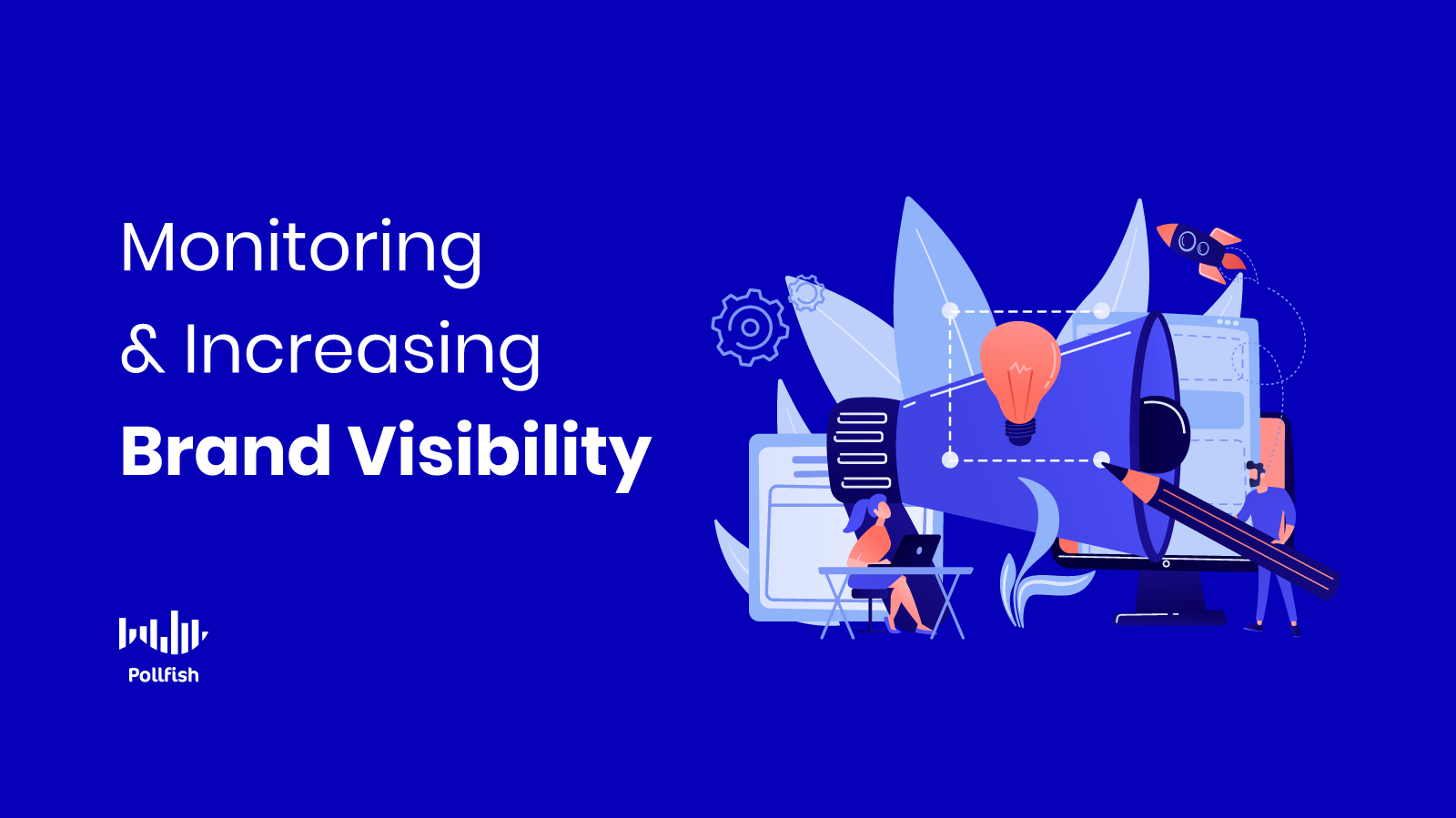
There is also the aspect of social listening as a means to monitor brand visibility across social media channels. Social listening involves tracking social media channels for mentions of your brand and product. This grants insights into how strongly your social media visibility is. It also allows brands to make improvements based on the disclosed preferences customers make on these channels.
Businesses can also forge band visibility with media placements. A PR task, these placements have traditionally been earned, but now, most businesses source a PR agency to provide these placements as another channel for brand visibility.
Or, a business itself may include a PR department that creates content, such as press releases and finds outlets and other sources to distribute the content. This, in turn, produces more digital visibility for a brand.
Aside from implementing these methods for better brand visibility, businesses can advance their brand visibility with surveys.
How Surveys Help Monitor and Raise Brand Visibility
Surveys serve a critical function in market research, as they allow businesses to conduct primary research around any topic and in any format, should the online survey platform used allow it.
Surveys help businesses understand how their brand is received and viewed, along with how visible it is. That is because they can cover virtually any topic in one iteration, or be broken up into smaller iterations that consist of several surveys.
There are various key subtopics that a brand visibility survey helps you better understand in relation to customers. First off, you can track brand recognition, which allows companies to understand whether or not their brand comes to the minds of customers when they see their product or service.
Next, there are the related topics of the brand and customer profile. When a brand changes its messaging, theme or image in general, it should track how well customers are aware of this change. Additionally, they should check whether this change has received visibility.
The same should apply to the customer profile; when your customer base changes, even to the slight degree of adding new segments with just one change (say a demographic addition), you should track this. That way, you will understand how to accommodate their needs by changing your messaging.
This kind of survey can also help you track the visibility of any other marketing campaign. For example, you can determine how many people have seen your advertisements, your video content, social media content and virtually all else.
As for increasing brand visibility, surveys that explicitly mention your brand bring more brand awareness by proxy. Additionally, the insights you derive from surveys will allow you to make informed decisions on how to increase your visibility — in a way that is appealing to your target market.
After all, visibility is important, so you must assure that the visibility your business receives is positive. Not all press is good press, so it is therefore necessary to run a brand tracking survey in addition to one that focuses on brand visibility.
How to Set Up a Brand Visibility Survey
Set up a brand visibility survey by first finding its larger purpose or purposes, prioritizing them and then organizing them into any of the topics mentioned above.
For example, decide whether you need to monitor the visibility of a new company announcement. Or, perhaps you may need to see how visible your advertisement is. Thus, each survey you create should be centered on specific topics. This will not merely organize your market research efforts, but keep your surveys short — a key best practice.
You can also design a survey for general brand visibility purposes, if you do not have a set campaign or sub-purpose to monitor for visibility.
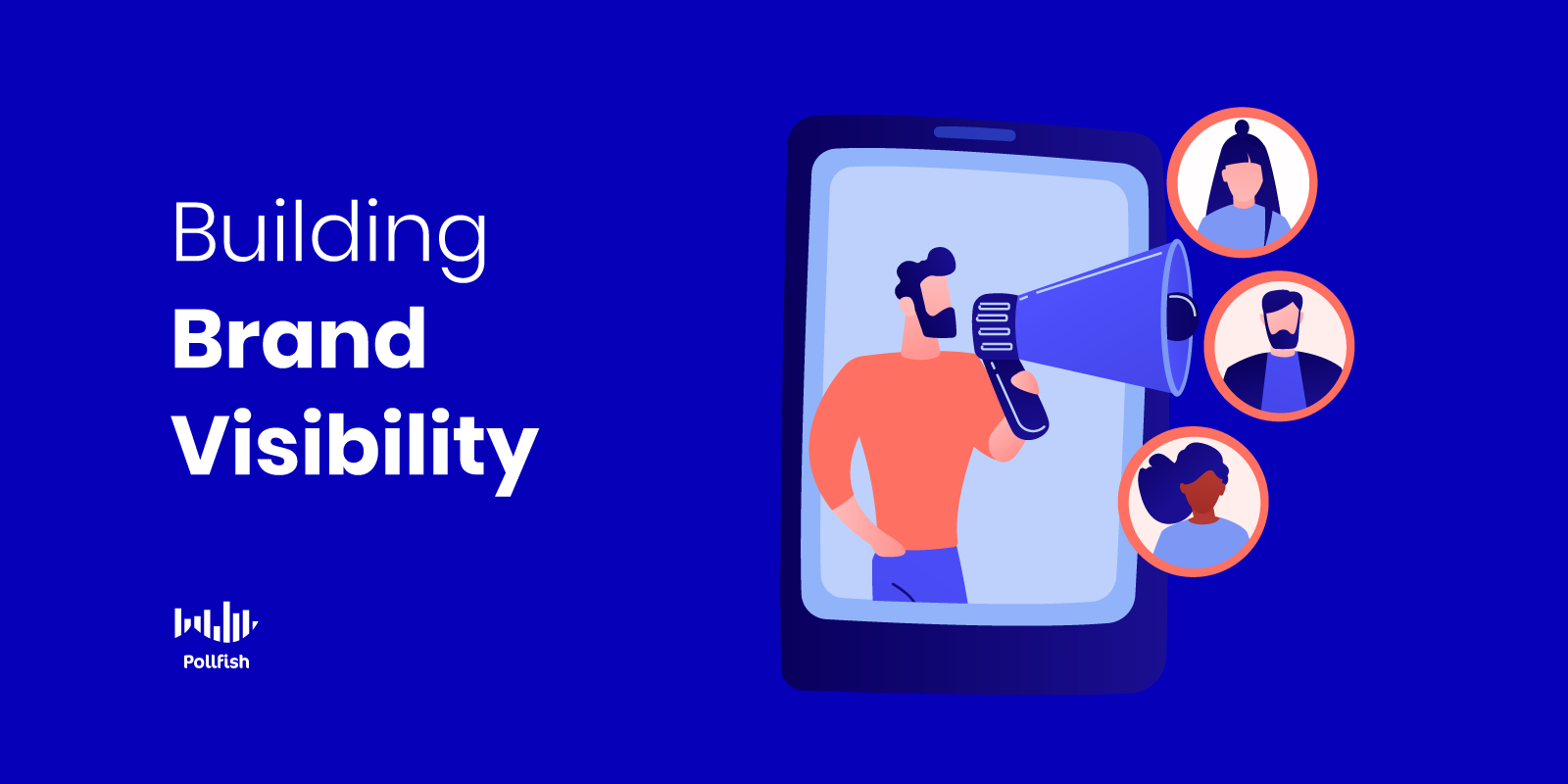 Then, identify the segments of your target market that you intend to study. When you use an online survey platform, you should be able to target those segments flawlessly.
Then, identify the segments of your target market that you intend to study. When you use an online survey platform, you should be able to target those segments flawlessly.
Afterward, create a set of questions based on the core concerns of your brand visibility survey. The following includes a list of question examples to use when setting up your survey.
- When you think of buying a product, which brands come to mind?
- Type of visibility question: brand recognition
- Answers: multiple-selection, with an open-ended “other” option
- Which brands do you think of when thinking about the [industry, niche]?
- Type of visibility question: brand recognition
- Answers: multiple-selection, with an open-ended “other” option
- Have you heard of [your brand name]?
- Type of visibility question: general visibility
- Answers: yes or no
- If yes, follow up with questions on the company
- If no, follow up with questions about a niche, if customers would like products that deal with issues in that niche, etc, then offer your product and ask if they’d like to learn more.
- Have you seen any of the following advertisements?
- Type of visibility question: advertising campaigns
- Answers: multiple-choice, must include images of ads
- If yes, ask questions about what respondents like/dislike about them
- What do you think of [company news/announcement]?
- Type of visibility question: company changes/ updates
- Answers: multiple choice
- Many in your target market may not have heard a particular announcement, this question will bring visibility to your news, while gauging customers' opinions on it.
Gaining More Brand Visibility for Your Business
Brand visibility is a key topic of contention in marketing, as marketing is largely bent on promoting a business in order to scale it. There are various methods businesses can apply to increase their visibility.
Some are examined in this article; there are several others that brands can attempt as a means to accelerate and augment brand visibility. In order to do so proactively, brands ought to conduct experimental research.
Consequently, surveys are the common denominator in experimental research and general market research. These tools allow brands to evaluate their target market on a variety of brand visibility-related issues.
However, in order to reap the most benefits from survey research, you must use a trusted source as your online survey platform. The strongest such platform uses RDE sampling, offers various question formats, deploys surveys across a massive network of sites, apps and other digital properties along with being able to conduct a survey in 5 easy steps.
Thus, the proper online survey tool makes all the difference in your brand visibility campaigns, allowing you to both monitor visibility, along with raising it.
How to Use Data for Decision Making
How to Use Data for Decision Making

In the digital climate of the present, using data for decision-making is ever-important for businesses to thrive and remain competitive.
While the vast majority of businesses claim to be data-driven, only a small fraction of businesses actually implement data into their corporate strategy. In a recent report, 99% of businesses reported investing in data and AI, but only 30% have a data strategy for their business.
As such, even the businesses that invest in data are not using it to its full potential — if at all. Without updated data, businesses cannot stay abreast of their target market, competitors and industry at large.
This article explains how to use data for decision-making in the market research space, so that businesses can fully grasp the insights from the vast array of market research techniques.
The Value of Data in Market Research
Market research is a particularly data-driven field, as not only do consumer preferences change rapidly, but so do the consumers themselves.
The latter occurs as a target market does not remain stagnant; new segments emerge, while others may change in terms of behaviors, demographics or needs.
Thus, market researchers must always keep tabs on their target market and overall industry, as this kind of information is invaluable. Researchers should not leave any data unused, but thoroughly analyze it and incorporate all of their data for decision making.
There is virtually no other aspect in the business realm as valuable as data, especially the kind that is delivered in a timely manner with up-to-date information. When you gather the correct amount of data from the most relevant people, you are then equipped with the necessary insights to take any action or inaction.
Whether it’s changing your marketing messaging, keeping up with your brand tracking, gaining customer loyalty or even increasing your CLV (customer lifetime value), having access to the right kind of data can help you improve your business in leaps and bounds.
After all, in order to make your target market aware of your business, delight customers and retain them, you need to understand them, their needs and expectations to the fullest extent. WIthout consumer data, you are essentially navigating in the dark.
This is largely because, as aforementioned, customer preferences and the makeup of a target market is highly subject to change.
As such, aside from investing in data, businesses ought to put it to use, to strategize with their data for decision making. When businesses leave their data dormant, then they are not data-driven.
Understanding Data-Driven Decision Making
The concept of being data-driven has driven a rise in claims across businesses, yet many do not commit to a data-driven culture.
When it comes to data implementation, one study has found that 94% of businesses say that they are beyond the planning stage of implementing data into their business, yet only 38% believe it is well-connected to the corporate strategy.
In another 2021 study, 62.0% of firms reported investing over $50 million in data and artificial intelligence, yet only 30% have built a well-defined data strategy.
Evidently, there is a disconnect between investments and usage. This can occur due to a number of reasons, including lack of time allocation to strategy or in-house resources that can fully adopt and adapt to the data.
First off, before attempting to foster a data-driven company, businesses ought to understand the precise meaning behind the term “data-driven.”
This concept alludes to a process of using data for decision making, in which researchers collect data, detect patterns from the data, put together an analysis and use that analysis to make inferences about subjects — particularly your target market — that would be used for taking actions.
Data-driven decision-making (or DDDM) has thus sprung from this concept. DDDM refers to the process of making data-informed decisions rather than anecdotes, past observations or intuitions.
Instead, the data a business derives from market research is used as the primary guiding source for decisions, changes and applications.
The Benefits of Applying Data for Decision-Making
There are various benefits of being data-driven, as outlined in a previous section, especially in relation to market research. There are plenty of more concrete ways in which data benefits a business, in ways that reach far beyond decision-making alone.
 The following lists the various other benefits that businesses can reap when they take up the DDDM position:
The following lists the various other benefits that businesses can reap when they take up the DDDM position:
- Data provides crucial insights that can enhance the overall performance of a business.
- They can do so by monitoring a variety of metrics that provide actionable insights.
- The DDDM position allows businesses to make incremental changes. This forges continuous improvements on various fronts, depending on the kind of data it uses.
- It is entirely fact-based, as such, decision-making is not entirely reliant on the knowledge or skills of any team members, but rather the insights themselves.
- The facts derived from DDDM enable a greater capacity to implement changes and scale them.
- DDDM is ideal for improving staff work and engagement, as it allows for greater transparency and accountability.
- It helps businesses identify their risks and threats to tackle them sooner rather than later.
- Collecting data is necessary for record-keeping and compliance, allowing companies to be accountable when it comes to managing data.
- It allows companies to prioritize their tasks and goals and deem which are practical and which aren’t.
- Results can be measured via the data collected, which is also ideal for market research techniques, whether it comes from studying:
- Employee sentiment via an employee feedback survey
- Product opinions via the product satisfaction survey
- Customer experience (CX) via a customer experience survey
- Customer development
- Thoughts on an advertising campaign
- Brand tracking
- It allows companies to justify taking an action or change by assessing themselves and their customers, testing different methods and understanding what is most useful for their target market.
How to Use Data for Decision Making
Although data is of the essence when it comes to making results-oriented decisions, it can be overwhelming to gather and parse. When it comes to the former, a business may not know all the applicable methods for gathering data, including how to reach out to its target market to aggregate the data.
In regards to the latter, a business may experience difficulty when analyzing data, including the ways to organize it and visualize it and make the next steps.
The following explains how to use data for decision-making with the DDDM approach.
- Narrow down a goal or issue to prioritize for your data.
- List the various problems your business is facing.
- List the various curiosities your business has in regards to its campaigns or target market.
- Find one or more issues that require the most attention.
- Once you've narrowed down an issue, decide on what you need to improve, or which aspects are in want of more information.
- Find a source of data best-suited for your DDM priorities from the first two steps
- Create a preliminary budget. Then determine which tool can best fort the budget and your data needs.
- Choose from the following:
- Website analytics
- Market research
- Secondary research: various industry publications, statistics sites and other sources
- Primary research: survey tools, online panels
- CRM software
- Business intelligence platforms
- Social listening tools
- Run a campaign around your source of data.
- After you’ve gathered your first round of data, organize it in a digestible manner.
- This will largely depend on the source you use.
- This may involve working with graphs, charts spreadsheets and more.
- Analyze your data.

Consider the following:
- Did you receive answers to your concerns?
- Do you need more information? If so, run another similar data extraction campaign.
- Divide your findings in the following ways:
- Descriptive Information: Includes all the facts from the data you collected.
- Inferential Information: Includes the facts, and their interpretation within the context of a particular project.
- Predictive Information: An inference based upon facts and advice for further action based on your reasoning.
- Draw conclusions.
- What new information have you gathered from your findings?
- Create a document with the most critical information you reap and share it with your team.
- Can you apply the findings to new strategies or do you need further insights?
- Has your data analysis confirmed or disproved your hypotheses?
- What new information have you gathered from your findings?
- Strategize and plan based on your data.
- Meet with other team members to discuss plans on improving strategies or creating completely new ones based on the data you derived.
- Measure and monitor your efforts — repeat if need be.
- Data-driven decision-making (DDDM) is not a one-off method.
- Rather, it should be used continuously to make accurate assessments about your customers, business campaigns and other crucial aspects pertaining to your business.
- Consider the following: did your DDDM decision lead to a positive impact on your business?
- If yes, that’s wonderful.
- If no, not to worry. It is better to be equipped with facts for making decisions and in the vent that you didn’t drive as much positive change, you can better decide future goals and strategies.
Creating Constant Improvements
Many companies, especially those in the tech field, seek to be data-driven. While most are open to implementing data for decision-making, a fractional portion actually follows through, as aforesaid early in the article.
Companies that have lagged on fully incorporating data into their decisions are not as well-suited to make innovations, test hypotheses and fully understand their customers' behaviors and needs. On the contrary, companies that do use data for making decisions avoid the pitfalls of strategizing on intuition alone.
The key is to prioritize your goal and use the correct data-culling tool. Given the sweeping area of studies that market research encompasses, it is important to rely on primary research in order to stay abreast of the latest needs of your target market.
As such, a market research data tool, such as an online survey platform is thus paramount to use. Such a tool makes it easy to create surveys, target the desired (and correct) sample, deploy the surveys and have them completed in a timely manner.
Businesses ought to choose wisely when it comes to selecting an online survey platform, as the proper kind will drive well-informed decision-making without any hassle.
Create Efficiency in Market Research with an Automation Survey
Create Efficiency in Market Research with an Automation Survey

Automation has been propelling technologies ever since its onset and market research is no exception. With an automation survey, market researchers can support a wide variety of effective survey studies and much more.
It goes beyond simply creating surveys, as it can support all the main types of research, including frequency-based research such as longitudinal. cohort and retrospective research.
This is because an automation survey can automate a wide variety of tasks that would otherwise be tedious and time-consuming.
This article elucidates the meaning and capabilities of an automation survey, so that you can create efficiency in market research.
Defining an Automation Survey
An automation survey denotes a survey or survey tool, i.e., the platform that enables or runs primarily on survey automation.
Survey automation refers to the automation of surveys, which involves all of their key components, such as the screener and the questionnaire, made possible through an online survey platform, with predefined rules, conditions and workflows.
In this context, an automation survey is thereby not merely a survey or survey type; rather it is a system that incorporates automation in various aspects. In turn, this minimizes the labor that market researchers would need to pour into their market research projects.
This kind of survey — or survey technique rather — allows market researchers to create effective surveys for all kinds of research campaigns. It is the chief manifestation of the adoption of automation in market research.
The Need For Automation
75% of companies use automation, specifically, marketing automation for their daily operations. 31% of businesses have automated at least one function a rise from years ago. These statistics point to a blossoming state of automation.
Automation has seen an increase in adaptation across businesses and industries — and for good reason. It offers researchers and employers of various industries to avoid doing routine, manual work that can easily be completed by robots and computers.

Aside from this self-evident advantage, which comprises the core of automation, automation presents other key advantages. They include the following:
- Allows you to extract large amounts of data in small time periods.
- This is especially crucial for market research.
- Frees up time so that workers can exert their efforts towards priorities.
- Helps avoid burnout in this way.
- Creates a more efficient use of materials.
- Forming a better quality of output if used correctly.
- Enables researchers to spend more time analyzing results to make better business decisions.
- Certain automation capabilities allow researchers to avoid survey bias.
- Sets a faster follow-up in motion in the research campaign.
- Gains responses in real-time with consistency in data quality.
- Allows you to engage a wide range of audiences for your target market and its segments.
- On a larger scale, automation has been discovered to boost productivity and raise the GDP.
The Power of an Automation Survey for Your Surveys
Survey automation works by way of the needs and preferences of your survey campaign. This is because the survey platform you use should enable you to set all the conditions you require of your respondents.
The Survey Screener: Automating Participation
A strong survey platform should have a screener that works by way of automation. This facilitates all the requirements of your respondents to be automatically collected. Thanks to this kind of automation, you don’t have to search for respondents manually on the Internet and implore them to take your survey.
Additionally, if that wasn’t enough of a relief, you don’t have to check the qualification of all respondents who enter a survey. This is a major convenience since there are many conditions you can set to qualify or disqualify potential respondents. For example, you may need to survey men and women ages 18- 50 in a particular area. Automation allows you to do so by presetting demographics.
You can also segment your survey in a hyper-granular way by adding screening questions with their permissible answers. This way, you can allow respondents to take the survey via behaviors, attitudes, psychographics and virtually anything else as it pertains to the respondent.
Quotas: Allowing You to gather the Right Amount of Participants
Automating the gathering and entry of qualified respondents is a major advantage of the automation survey. It also does more via quotas. A quota is a set quantity of a particular feature (response) in your survey.
A strong automation survey ought to include quotas in the screener, so you wield full control over who takes part. This means, aside from who participates, you’ll get to control how much. For example, you can set your survey to an overall quota of 2,000 completes in most survey platforms.
But a true automation survey should allow you to take this concept further.
Such a survey should allow you to add quotas on all the respondent qualification categories. For example, your study may require surveying more people of a particular ethnic background or age. You should be able to allot quotas to all the respondent qualification categories: demographics, geolocation, mobile usage screening and more.
Additionally, an automation survey should allow you to automate the number of responses per screening answer. If your survey permits respondents of multiple screening answers to take part in the survey, you should be able to assign each screening to answer a quota. This is one of the most granular ways to gather the correct respondents, and more precisely the correct amount.
It becomes possible due to automation. But there’s so much more that this survey tool can do for your market research; it can automate a wide variety of tasks to ease your workload and gain accurate results.
Boring Tasks That a Survey Can Automate
There are several boring tasks in the market research process that an automation survey can get rid of, through the prowess of automation.
The following enumerates some of these key tasks. Bear in mind that not all automation surveys are built alike — therefore, not all such surveys offer the same kind of automation capabilities.
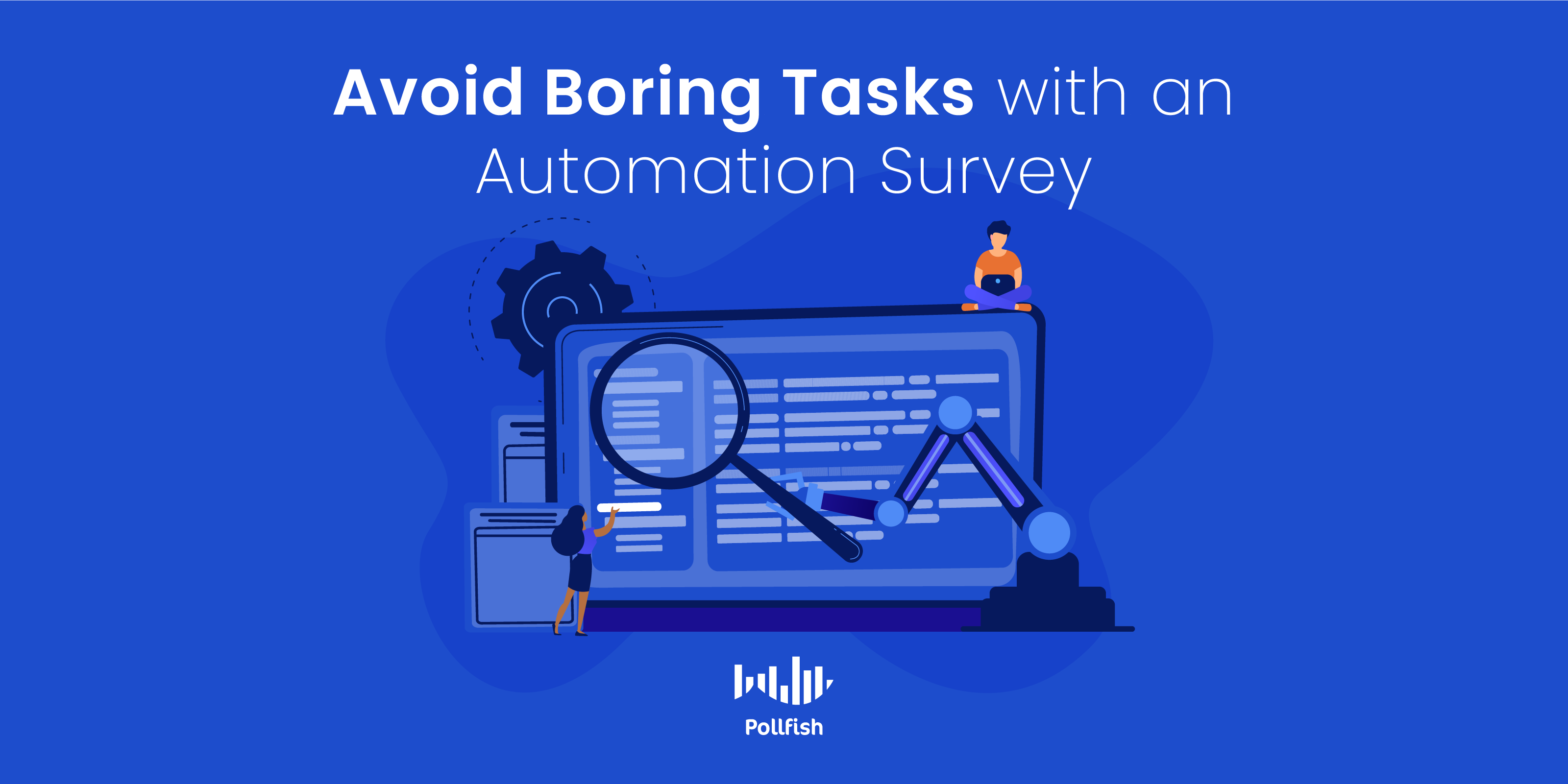
- Skip Logic: Also known as survey routing, this is a valuable function for both retaining responses (thus lowering survey attrition) as well as giving you the correct insights.
- This allows you to send respondents to relevant questions based on their responses to a previous question.
- Deployment: Not only won’t you have to fret about which networks, websites and apps will allow you to distribute your surveys, you won’t have to manually send them out to the networks, as the survey automates all of this.
- Iteration: An automation survey will not stop iterating across different websites and apps until it fulfills all of its quotas. Thus, you can rest assured that you’ll never come up short.
- Data Organization: An automated survey does not merely cull data. It will organize everything for you, possibly rendering you to rethink storing it in a spreadsheet.
- It should also give you the option of crosstabs and other kinds of exports of organized data.
- Visualizations: Data will not be displayed in just one manner. Instead, you can view it in a variety of formats.
- This is because this data should be displayed in various visualizations: pie charts, bar graphs and spreadsheet-esque displays which feature the most popular to least popular answers.
- Quality Checks & Disqualifications: Even if your respondents pass the screener portion, their surveys may not count towards the final number of completes/quotas. This is because some survey respondents that you should keep an eye on providing faulty, inaccurate answers.
- Instead of gathering low-quality data to be filtered by in-house experts after a survey obtains all of its quotas, an automated survey includes quality checks as the survey is running. These will automatically disqualify respondents who use a VPN, provide gibberish answers, along with other faulty data.
- Incentives: Most people don’t have time to spare; incentives are one of the most powerful motivators for online users.
- This survey tool incentivizes respondents right then and there, without the need to manually reach out to them, thereby keeping their identities anonymous.
The Disadvantages of the Automation Survey
While this tool allows you to perform market research across verticals and research campaigns, it too has several drawbacks. As a business owner, market researcher or general researcher, you ought to be wary of them all.
Here are some of the shortfalls of automated surveys:
- Subject to survey attrition: No survey form is immune to attrition. Some respondents will simply drop out before completing their survey. There are certain best practices that can help you avoid this.
- Cannot undo an automated task: Once you preset a certain function, be it a quota, a question or a skip logic rule, it cannot be undone. If there is some automated feature you need to redo, you would need to run another survey.
- Vulnerable to Basic Insight: While you can create qualitative surveys, they may not be as insightful as a phone or in-person interview.
- You can correct this with open-ended questions, but with a lack of an interviewer, you won’t be able to probe further on the answers to these.
Excelling Market Research with Automation
Automation is here to stay; luckily the market research space can benefit from it with the automation survey. To reiterate, this is not merely a survey type, as it can refer to a platform along with its native surveys.
While many online survey platforms offer automated surveys, they are not equivalent on any front, including on their automation capabilities. The proper automated survey platform will allow you to complete all the functions stated in this article, along with allowing you to reap all of the aforementioned benefits.
As such, you ought to choose wisely in your automated survey tool; consider it the driving force behind all your market research endeavors. Even if you decide to conduct experimental research, a survey is still the most substantial tool for amassing primary research about your target market and all else.
How to Forge Inclusive Design in Market Research
How to Forge Inclusive Design in Market Research
 Market researchers should aim towards creating an inclusive design in their market research campaigns.
Market researchers should aim towards creating an inclusive design in their market research campaigns.
This is important in a number of ways and can be used to optimize various primary market research techniques, whether they are intended to examine product satisfaction, a workplace, a target market, a new product launch or the vast set of other market research studies.
While it may appear to be a feat to create inclusive design in market research tools, it is possible with surveys, provided you use the proper online survey platform and incorporate best practices for inclusive design.
This article explains inclusive design in the market research sphere, why it is important, how it benefits surveys, research and a business at large, along with how to establish such a design in your market research campaigns.
Defining Inclusive Design
Inclusive design refers to the design approach that recognizes the full range of human diversity, taking into account various circumstances such as ability, language, gender, age, culture and other forms of difference.
The principle of inclusive design is to ensure that no one is excluded from various products, technologies and digital experiences.
Fixed on designing experiences that are as inclusive as possible, inclusive design involves creating solutions that suit users with specific needs and abilities. Users with disabilities are particularly at a loss when interacting with products and digital experiences.
Such users should not be ignored, as they deserve to be seen and heard — they too make up a target market and ought to be studied in market research. However, many designers, including those in the market research space overlook this. Consequently, disabled users suffer the outcomes.
In the United States, 1 in 4 Americans suffers from a disability. With inclusive design, designers across sectors can create inclusive experiences so that no user undergoes difficulties or accessibility issues.
However, businesses must remember that inclusive design does not solely focus on accessibility and catering to users with disabilities. Rather it takes this notion and extends it across a wide spectrum of circumstances that various respondents go through.
The Importance of Inclusive Design in Market Research & Surveys
Inclusive design is both applicable and important in market research, as researchers study all kinds of people in a given target market and its various segments. As such, they must cater to a diverse range of human experiences to avoid them any trouble.
In this way, inclusive design is not solely a concern and responsibility for designers. Researchers are essentially the designers in market research campaigns — whether they are conducting phone interviews, a focus group, a survey panel, in-person interviews or most commonly and conveniently — a market research survey.
Inclusive design is important for a number of reasons. The following explains these reasons, some of which may not be as evident as others and are thus crucial to consider.
- Without an inclusive design, scores of key target market respondents will leave the survey. Thus, it directly causes survey attrition.
- An inclusive design makes it easier for a diverse set of respondents to complete their survey.
- Surveys not designed with inclusivity as a priority will be brushed aside or left incomplete, increasing the completion time to gain all survey quotas.
- Without inclusivity, many key respondents will bear bad associations with surveys, preventing them from taking future surveys, even if those surveys are optimized for inclusivity.
- Your brand will be poorly regarded if the survey mentions it or displays it at any time.
- Surveys and other market research tools that don’t incorporate inclusive design are a waste of time, labor and resources.
- Inclusive design that covers all areas of diversity will make customers feel visible in regards to their unique circumstances.
- An inclusive design in a survey that explicitly mentions a brand will frame the brand in a positive light among customers, as it will show them that the brand has empathy and respects them.
- Such a positive experience, along with others will increase respondents’ willingness to participate in future survey/ market research campaigns.
How Inclusive Design Differs from Accessible Design
Inclusive design and accessible design are similar concepts, centered on the idea that disabilities are bound to come up whenever users interact with any environment. They both aim to put an end to any difficulties different users may face by improving the environment itself, be it on a digital property or a product.
Inclusive design often focuses on making surveys and other tools more accessible to users with disabilities, thus it carries some aspects of accessible design. Although these terms are used interchangeably, they differ in considerable ways.
The following illustrates how accessible design and inclusive design differ, so that you can avoid mistaking one for the other.
Accessible Design
This concept is most concerned with the results of a design project. It uses accessibility guidelines as the framework for any campaign. Such guidelines are published by government agencies and industry groups to ensure that those with disabilities have ease of access in digital spaces.
Closely tied to government and law, this idea focuses on producing the best outcomes for users with special needs.
Inclusive Design
This idea is focused on the design approach rather than outcomes. As such, it includes different methodologies on how to create more inclusive environments, be they online or in-store. Like accessibility, it involves better serving those with disabilities.
However, it also encompasses a broad range of diverse people and situations, taking into account things like gender, religion, age, quality of life and more.
Creating Inclusive Design in Market Research
There are various efforts market researchers can take in order to generate inclusive design in their surveys and other methods of garnering primary research. First off, businesses must remember that inclusive design does not simply concern itself with accessibility.
Instead, research departments must forge surveys or other research tools/methods that bear in mind a wide set of situations that diverse populations face. When forging inclusive design, market researchers must create surveys that show respect and heedful attention to a variety of factors in order to avoid making research participants uncomfortable or unable to partake.
Instead, an inclusive design should make market research participants feel at ease along with being shame-free and pressure-free when they take part in a study and answer various questions.
The Three Dimensions of Inclusive Design
In order to cater to the above target conditions and factors, researchers ought to familiarize themselves with the three dimensions of inclusive design. These pillars dictate how to optimize the user experience (UX) in order to establish inclusivity.
Designers and market researchers alike must incorporate these critical concepts into their inclusive design strategy, as they address the many factors that inclusive design must work towards. The following explains what they are along with tips on how to implement them:
- Understanding diversity and uniqueness
- Remember that each respondent is unique.
- The needs of outliers or special needs users are diverse.
- A “mass solution” will not be ideal. Rather, consider individual circumstances.
- However, do not use segregated solutions; they’re not economically sustainable.
- Instead, opt for personalization and flexible layouts.
- Avoid systems that make choices for respondents, instead allow for self-determination and self-knowledge.
- Inclusive processes and tools
- Design teams and researchers should those who have lived a special needs/extreme user situation.
- Or, they must consult with them to proactively create inclusive surveys, etc.
- In addition, these teams must either incorporate or consult with a diverse group of people.
- This links the design with the application
- The larger beneficial impact
- Market researchers should be fully aware of the context of any research campaign, along with how participants may interpret and perceive it.
- Inclusive design should incite a continuous streak of inclusion; this involves using inclusive design in various design aspects.
- Understanding diversity and uniqueness
How to Create Inclusive Design in Market Research for Various Conditions & Demographics
The following enumerates the key targets of inclusive design along with how to optimize for these particular circumstances and demographics.
While there is no specific formula to master inclusive design, researchers can make much headway in this by considering the following situations and demographics and their corresponding advice for inclusivity in surveys and other tools.
Inclusive Design for Various Types of Disabilities:
- Visual
- Create larger font sizes across devices.
- Use color contrast best practices
- Auditory
- Use surveys as opposed to calls, in-person interviews and focus groups
- If you conduct studies via speech, assure that respondents are equipped to hear you.
- Cognitive
- Create icons next to concepts for a clear understanding of questions/ themes
- Explain the purpose of a survey before the screening section.
- Do not ask for respondents to click when an option can be automated
- Physical
- Opt for phone interviews or surveys.
- Be mindful of the questions you ask in regards to physical abilities and disabilities.
- Avoid crossing personal boundaries in the questionnaire.
- Speech
- Opt for surveys.
- Be mindful of the questions you ask in regards to speech abilities and capabilities.
- Avoid crossing personal boundaries in the questionnaire.
Diverse Social Factors:
- Race
- Ethnicity
- Gender identity
- Use imagery that includes a wide range of demographics (include variations of the first 3 social factors)
- Include your company’s commitment to diversity and inclusion in the intro and the post questionnaire “thank you” section.
- Sexuality
- Do not posit any questions that take a stance on sexuality.
- Include same-sex marriages and relationships in questions that pertain to domestic and romantic relationships.
- Do not exclude same-sex parents in applicable questions.
- Political standing
- Keep your questions politically neutral.
- Assure the privacy of your respondents, as politics can be a personal and sensitive matter.
- Do not suggest any political siding.
- Reading proficiency
- Use reading levels and word-choice appropriate for your target demographics.
- Add icons whenever possible for more clarity.
- Economic factors
- Assure respondents of their privacy and anonymity.
- Rather than using specific quantities for salary/income info, use ranges
- Culture & religion
- Avoid stereotyping.
- Bear in mind that some matters are considered taboo in some cultures and religions.
- Do not take a stance on any issue that pertains to a culture.
- Country or residence
- Use the appropriate language when surveying residents of different countries
- Use the appropriate privacy requirements as they pertain to different countries. (Ex: GDPR in the EU, for example).
Forging Ahead on Inclusion
An inclusive design approach to market research allows businesses to seize vital opportunities for business growth by making surveys more accessible and considerate to a diverse array of circumstances that different respondents face.
Whether they face a disability or have sensibilities pertaining to their culture, it is key to create fitting surveys so that all respondents can take part without incurring any difficulty or discomfort.
While there are several routes you can take to obtain primary research, survey research allows market researchers to be more inclusive, without giving up efficiency. Aside from catering to the hearing-impaired, surveys provide anonymity and allow researchers to ask sensitive questions.
The key is to find a competent online survey platform that allows you to create inclusive design in your survey research. Such a platform streamlines market research campaigns and allows researchers to create inclusive surveys to a vast array of demographics.
Diving into the Cognitive Testing Survey to Reduce Research Bias
Diving into the Cognitive Testing Survey to Reduce Research Bias
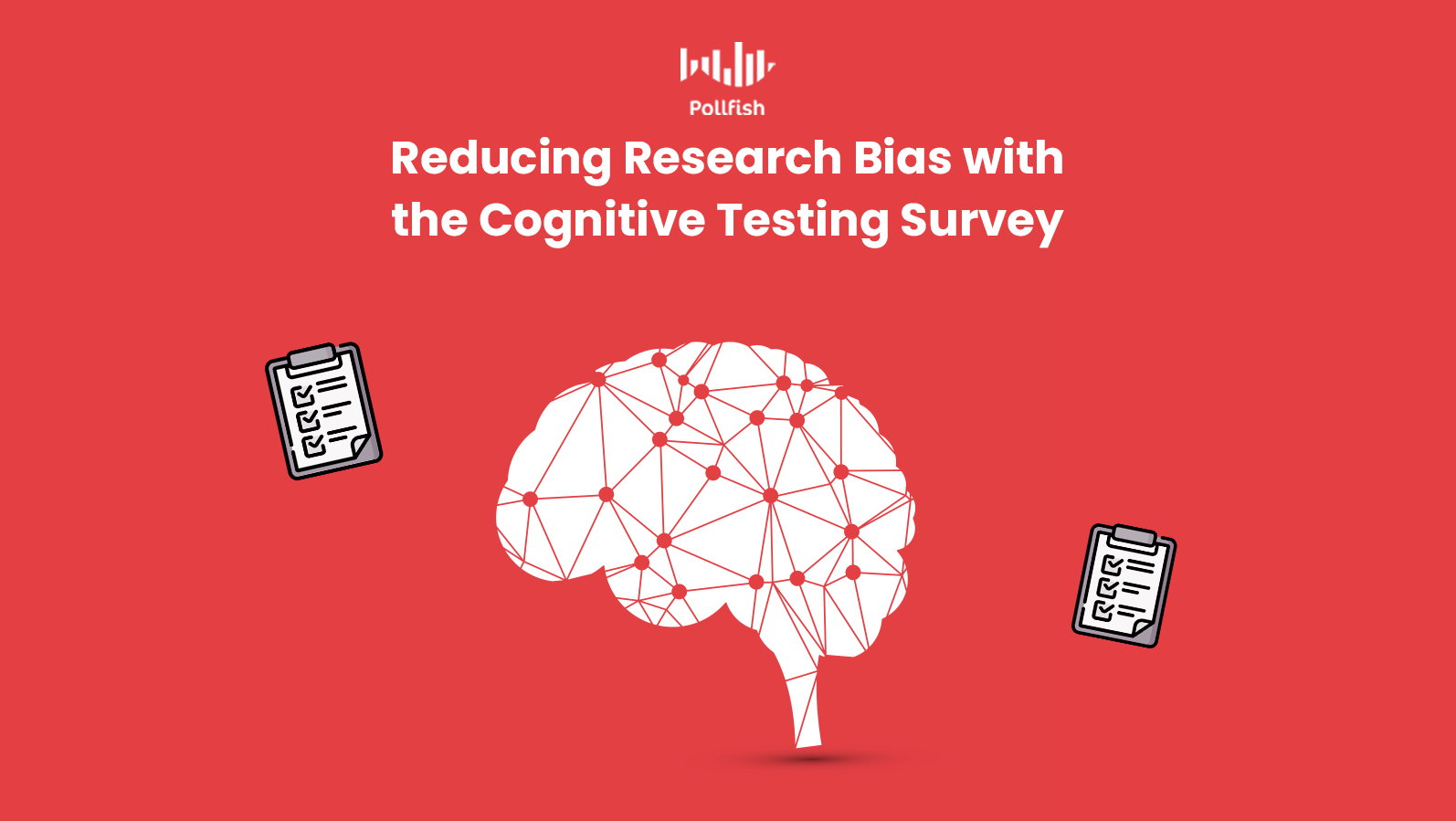
The cognitive testing survey incorporates a critical tactic used in market research used to reduce bias. Particularly in reference to reducing bias originating in survey questions, this kind of survey allows researchers to develop questions that avoid cognitive bias and other biases.
No one is immune to biases, including researchers who form the questionnaire — the heart of a survey and its broader campaign. Given that both researchers and their respondents are prone to survey bias, researchers must find ways to eliminate the bias, and this begins with the questions themselves.
Cognitive testing allows researchers to build better survey questions to fend off cognitive biases and thereby create more reliable and accurate campaigns.
This article explains the cognitive testing survey, its broader concept, how it improves survey research and market research at large, along with how to create one.
Defining Cognitive Testing
Cognitive testing is a method in market research used to test how comprehensible survey questions are to respondents in order to improve them. It is therefore an optimization method used so that researchers can foster effective surveys for market research campaigns.
It should not be confused with cognitive interviewing, a practice used by the police when dealing with witnesses.
During a cognitive test, researchers probe participants on their cognitive processes during the question-answering portion to find problems with those questions. This way, researchers can form better questions for their survey studies.
This kind of test is designed to improve the quality of answers by limiting cognitive bias, which is a kind of preconceived notion stemming from existing, perceived to be existing or lack of information that skews perception and leads to misconception.
However, it does not solely aim to limit cognitive bias; rather, cognitive testing helps build inclusive research design, a kind of design methodology in which researchers consider the complete scope of respondent diversity in order for respondents to complete a survey accurately and with ease.
The kinds of diverse factors researchers must consider include ability, language, culture, gender, age and other differences. The goal of cognitive testing and its own survey is to make a market research survey more inclusive and minimize research bias.
Understanding the Cognitive Testing Survey
As its name suggests, the cognitive testing survey is a kind of survey designed as a tool to perform cognitive testing. A part of inclusive research design, this kind of survey seeks to weed out several issues within questions that would otherwise incur miscommunication and biases on the part of both the researcher and respondent.
Particularly designed to improve the experience and accessibility of the respondents, this kind of survey works to avoid biases and inaccurate information from the respondents. This survey is specifically designed to avoid cognitive biases in market research, such as in other surveys themselves, but it can be applied to any form of research in which responders are questioned.

The cognitive testing survey tests respondents questions in order to avoid the following:
- Confusion in survey questions or answers
- Misinterpretations of questions or answers
- Difficulty in properly answering questions
- Feelings of irrelevance when in fact questions touch upon relevant matters to respondents
Poised to make surveys more comprehensible, this survey type functions as more of a test on researchers’ upcoming or prospective survey studies rather than a study on consumers. It shows researchers the flaws within their own questioning and formatting.
As such, when researchers create a cognitive testing survey, they can test questions to various campaigns and survey types. In this regard, this is one of the most thematically diverse survey types.
The Pros and Cons of the Cognitive Testing Survey
The cognitive testing survey serves as a useful test run of a survey before it is launched. However, it does not cover all bases when it comes to inclusive research design, or understanding respondent perceptions.
As such, market researchers ought to understand its advantages and limitations before running such a survey. The following lays out the various benefits and drawbacks of this kind of survey:
The Pros
- It provides a direct method to understand how respondents interpret the questions and instructions you aim to use in potential surveys.
- It allows you to understand the various meanings associated with your questions.
- It exists as a pilot test or test run, so that you avoid running several surveys.
- It allows you to avoid guessing which respondents answered accurately and which didn’t due to a misunderstanding.
- It shows you how different respondent conditions or abilities affect respondents’ faculty in answering the questions.
- It is a far more proactive approach to inclusive design and avoiding biases than merely adjusting demographic questions.
- It helps ward off would-be biases from the respondents should the cognitive testing survey not have been run.
- It prepares you to create questions that are better suited to be understood by your target market.
- It works to prevent respondents from answering with “don’t know” or “not sure” in future surveys.
- It helps form standardized questions and reliable answers.
The Cons
- It doesn’t tell you all of the thought processes that occur among respondents when they answer the questions.
- You won’t be able to see if respondents understood particular terms in the question or the question itself.
- You won’t know if respondents accurately recall the kind of information needed to answer a question.
- It can’t relay whether respondents can fit their desired answer into the provided format or answer categories.
How to Create a Cognitive Testing Survey
Although the cognitive testing survey has its share of limitations, it can still explore the items listed under the above “cons” section. This will rely on the way that researchers frame their survey questions.
This is to say that some questions will be one-offs, while others will require follow-up questions to understand the respondents’ interpretations and opinions in greater depth.
When executing a cognitive testing survey campaign, researchers can compare data produced over time by the same and different segments of a target market.
First off, the survey questions in this type of survey are delivered via the technique known as “mode mimicking,” a method that asks questions in a mode as close to the main survey (the one you’re testing for) as possible.
This means the format of the questions and the questions themselves must be virtually identical with the survey you’re testing. If, for example, you intend your actual survey to use a Likert scale question, you should test it in the cognitive testing survey as well.
In this survey type, it is more crucial to use advanced skip logic, that is — the automattic function wherein respondents are routed to appropriate follow-up questions based on their answers to a previous question.
This will allow researchers to understand their respondents’ comprehension and interpretations to a granular extent, so that they can perfect their surveys and avoid any cognitive biases.
Furthermore, the cognitive testing survey naturally fosters qualitative market research, as it must also include open-ended questions so that respondents are at liberty to explain themselves. After all, the point of this survey type is to optimize the survey experience and avoid any confusion.
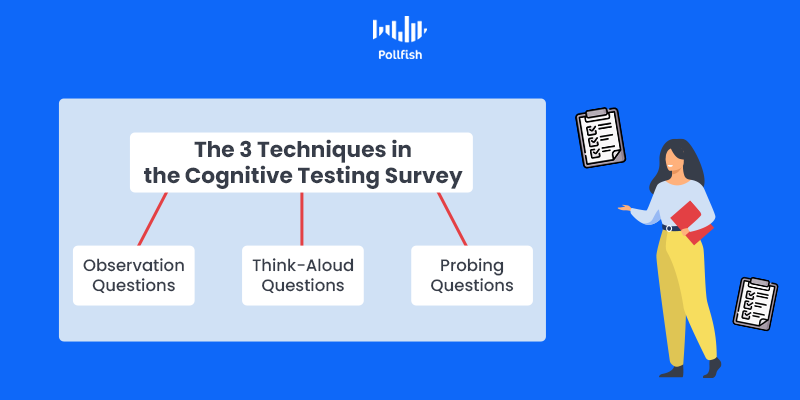
There are three main techniques used in questioning the respondents in a cognition testing survey:
- Observation Questions: This involves questions that seek out hesitation and confusion
- Particular to the cognition testing survey are requests for clarification.
- As such, researchers must include this as an option, unlike with most survey types that simply include a “don’t know” option.
- Example: An option with an open-ended answer that allows responders to explain what they don’t understand.
- Think Aloud Questions: This involves respondents expressing their thought processes in writing.
- As such, these questions must include an option for an open-ended response. They can also ask multiple-selection questions that deal with thoughts.
- Example: “Please explain what immediately comes to mind when you see this kind of question.”
- “Please explain how you think about answering this question.”
- “Does this question create an instant answer or does it take some time for you to answer it?”
- Probing Questions: These questions inquire into the way respondents perceive a particular word or phrase, the scope of time they think about when recalling information and whether they believe a question is missing any options.
- These questions can be asked one after the other by way of skip logic or after the entire test questionnaire.
- Example: “What do you think of when you see this word?”
- “What time period in your life do you think about if you were to answer the following question?”
- “Which phrase would make you think of a physical home?” (Multiple-choice)
Creating Inclusive and Bias-Free Market Research
In summary, the cognitive testing survey takes the concept behind cognitive testing and reimagines it as the basis of the survey. Running this kind of survey across multiple segments of a target market saves money, time, resources and the manpower required to carry out the study, analyze it and test it further.
Even the sharpest of researchers will understand that no survey will be interpreted exactly the way it is intended to or in the same way. As such, researchers should preface their survey campaigns by running the cognitive testing survey.
This will stave off various biases, as it teaches researchers which question formats and wording to avoid, and which will be most easily and accurately interpreted by respondents.
Given that target markets may include those with disabilities, those with particular interpretation patterns and simply those who think differently, it is key to design surveys to their favor and understanding. Doing so will ensure you foster inclusive market research along with stamping out biases.
The key to carrying out this kind of survey is by choosing the proper online survey platform. Such a tool should make it easy and practical to run numerous surveys, test various segments of a target market, cull the information with relentless quality and retrieve results quickly.


 The Detractors
The Detractors











